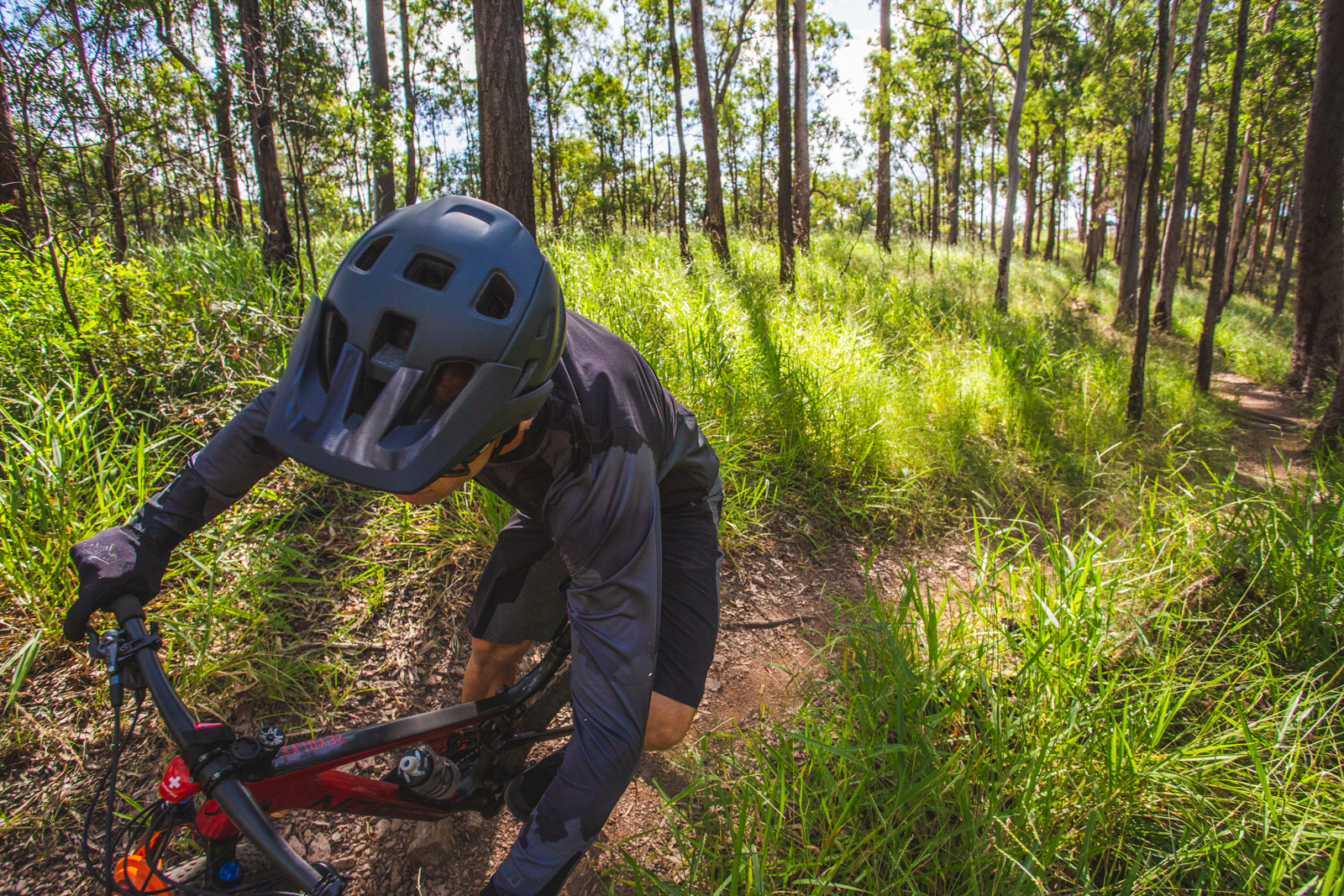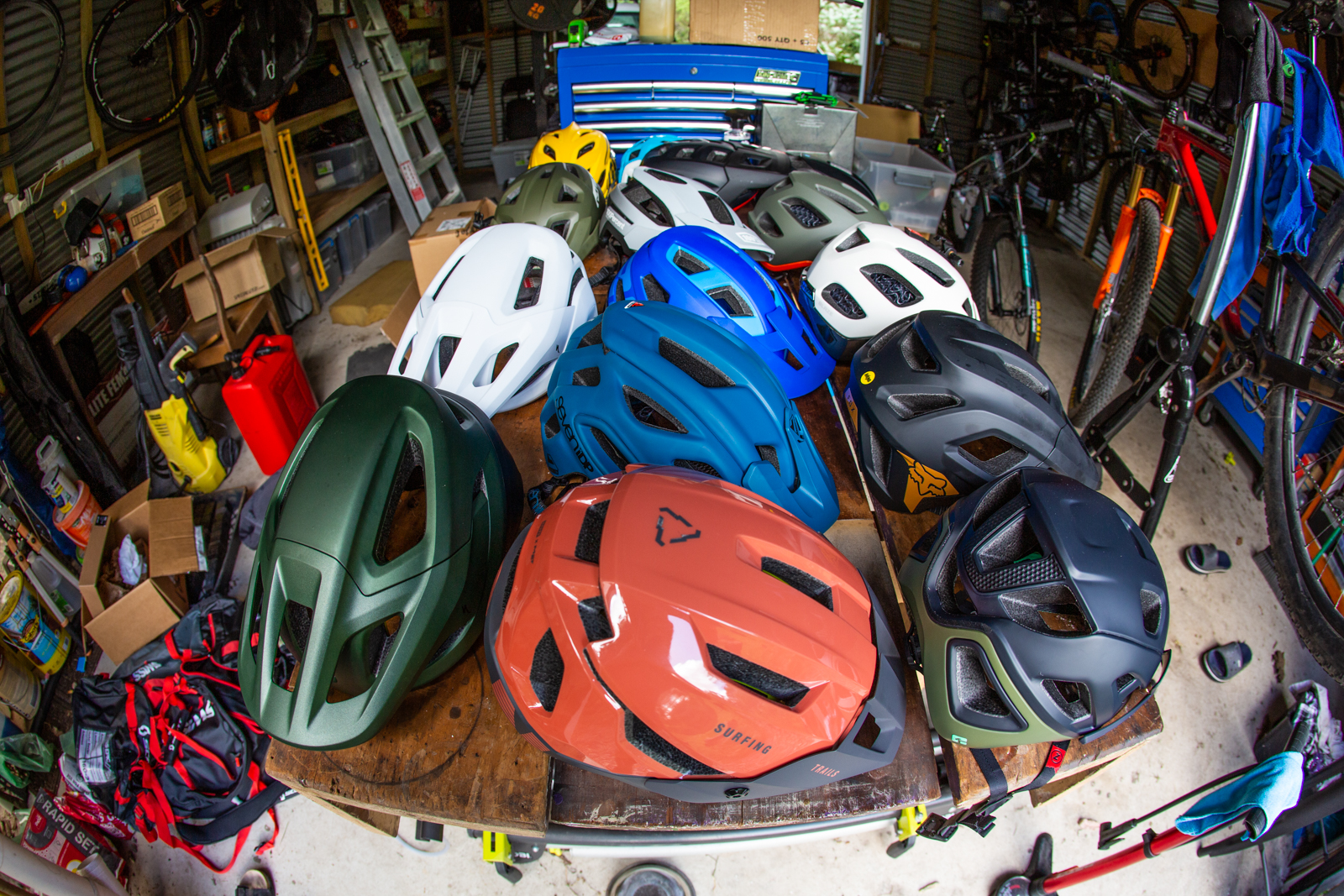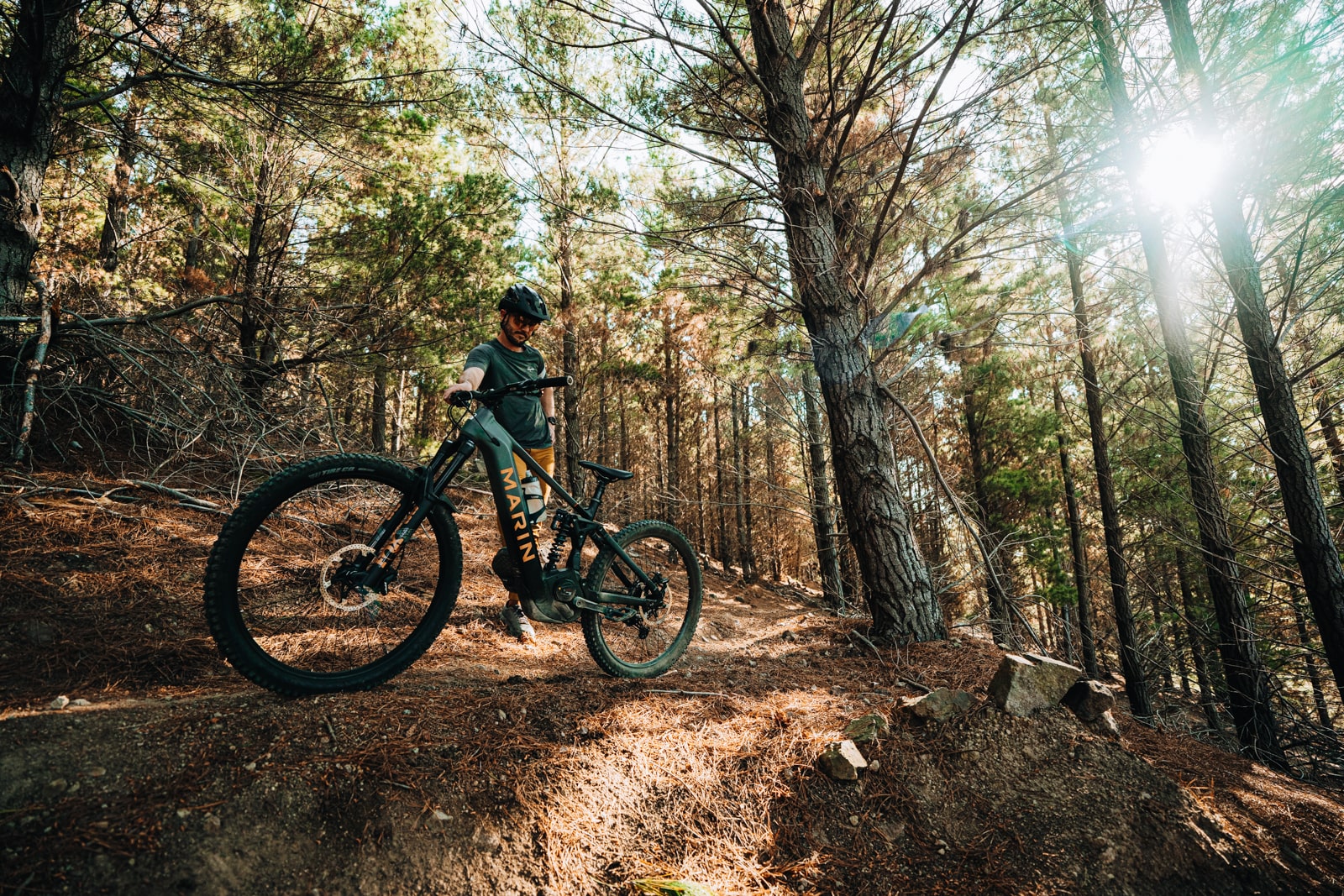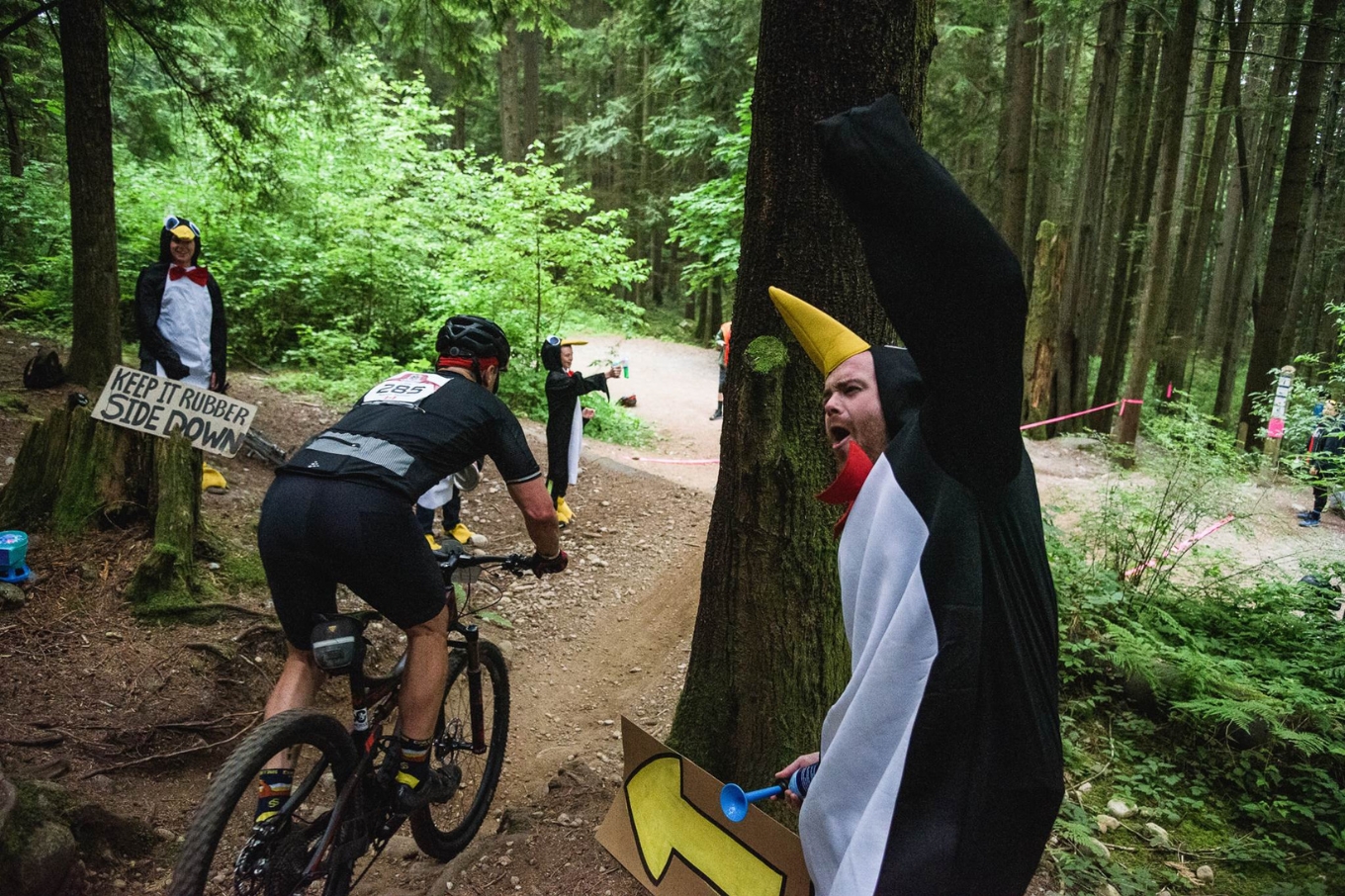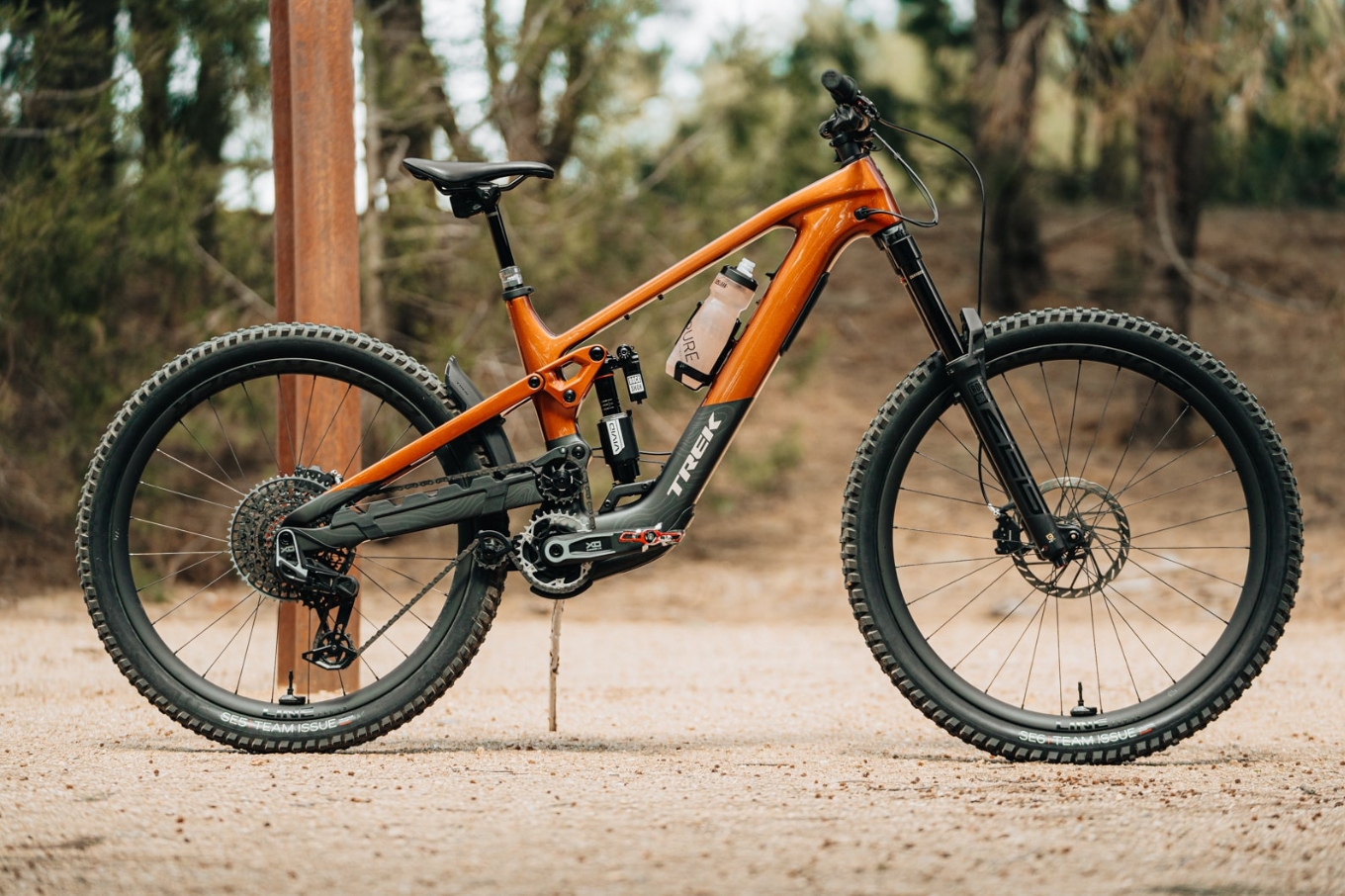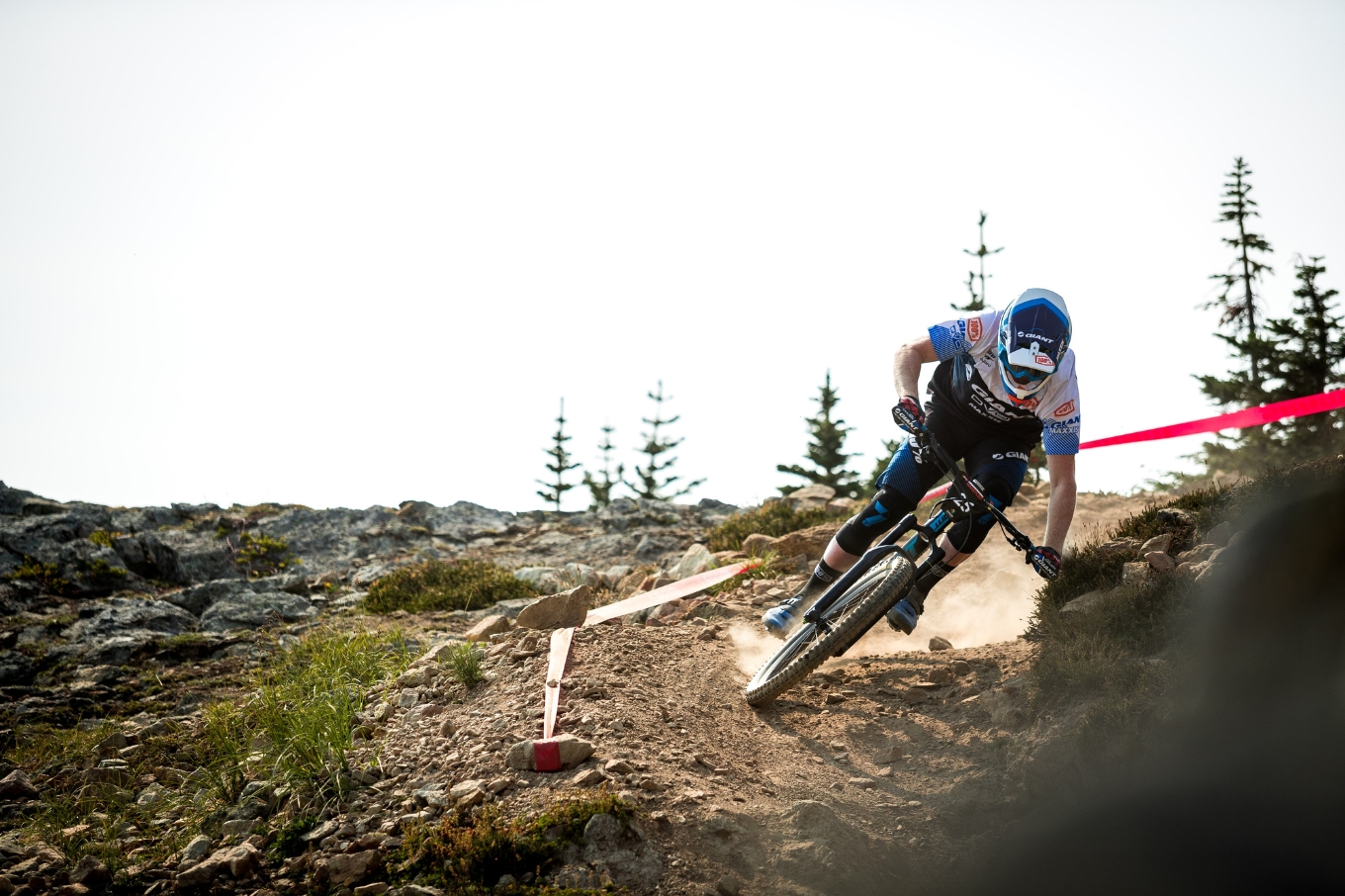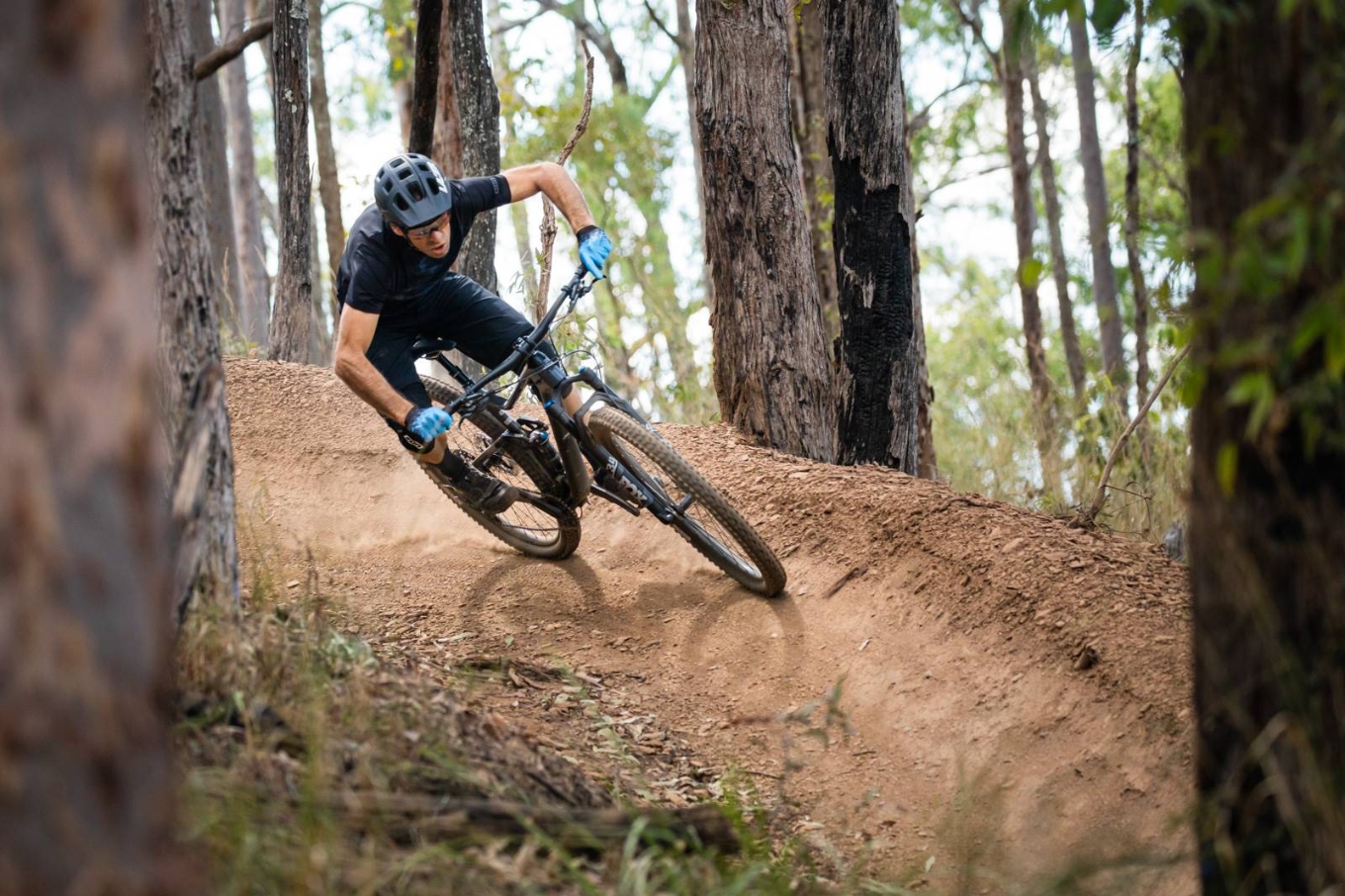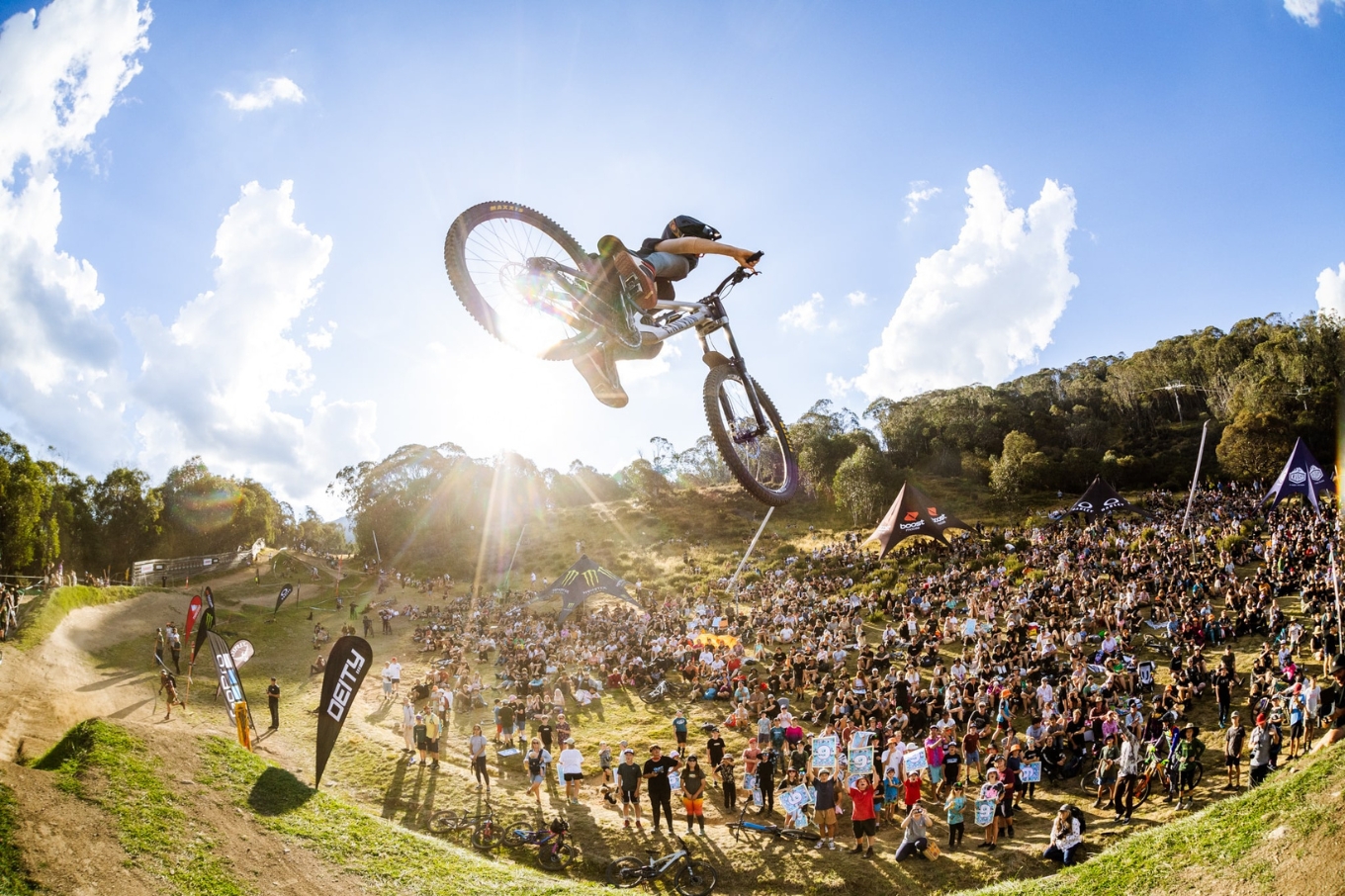AMB Mountain Bike Trail Helmet Group Test
Need a new trail helmet? We tested over a dozen mountain bike trail helmets - here's how they compare.
Photos: Gerard Lagana
A helmet is the only mandatory piece of safety equipment you need to ride a bike in Australia. It might be different for some events, but the general thinking is our heads are best protected when we're moving faster than we can run. Helmets have progressed a long way in terms of coverage, ventilation, fit, relative comfort and of course – increased protection.
What we tested
Got a helmet in mind? Click straight through to the review:
Lazer Jackal Kineticore
Fox Mainframe
Bontrager Blaze WaveCel
Bontrager Rally WaveCel
100 Percent Altis
Troy Lee Designs A3 MIPS
MET Echo
Specialized Ambush 2
Specialized Camber
MET Terranova MIPS
100 Percent Altec
KASK Rex
Limar Delta
7iDP M2
ION Traze AMP MIPS
Fitting your helmet
- Make sure your helmet's shell size is a secure fit, sitting horizontal on your head.
- Ensure the straps make a neat Y underneath your ears.
- Tighthen the chin strap enough so when you yell 'YIEWW!' you feel the pressure of the strap.
- Use the retention system to help secuer the helmet at the base of your skull.
- If you can't make the helmet stable, try a different size or a different brand.
What about using a full-face helmet?
We kept this test to open-face helmets, but if you would feel more secure in a well-ventilated full-face helmet then buy one! The fit is a little different so do be sure to get advice from your local store on how to fit your helmet so it's safe and secure. A well-fitted full-face helmet will bring far more protection with extended coverage at the rear, plus for your jaw and the side of your head.
We test the Specialized Gambit full face helmet.
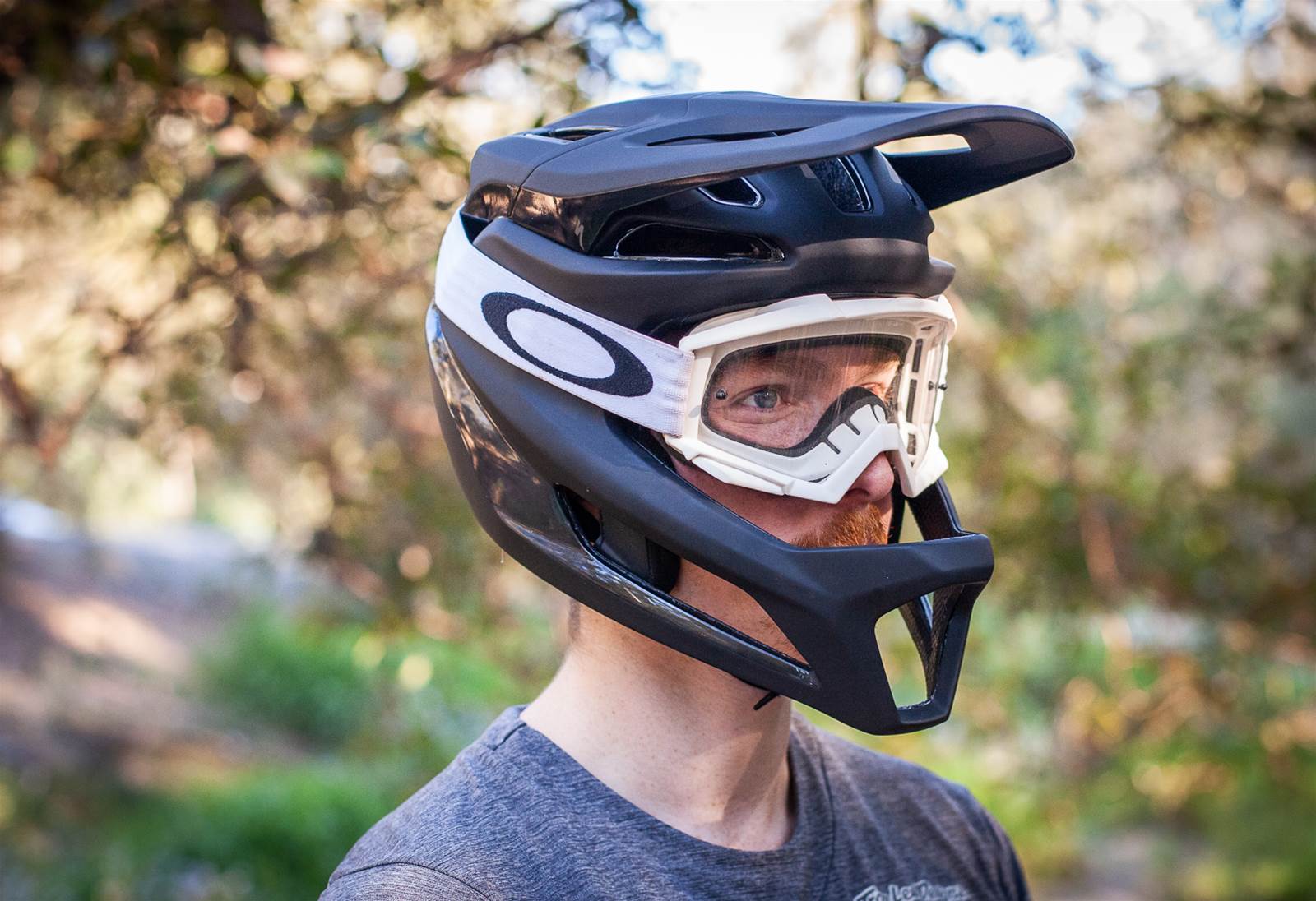
Why do I need rotational protection?
MIPS introduced slip liners to reduce the immediate impact force to your head. While the EPS foam takes care of blunt force trauma, reducing the impact of rotational impact via 10-15mm of rotational deflection can help reduce the rotational acceleration applied to your head – and brain.
Turning heads – all about rotational impact protection like MIPS, WaveCel and Kineticore.
By the numbers
15 helmets tested
1 stupid crash
1 visit to the doctor
15 degrees of temperature variation during testing
4 lots of feedback to helmet brands
'But you didn't test…'
We approached all major helmet brands for inclusion in this group test, and tested every helmet model supplied. Most of the brands have more models at higher and lower price points, and with road/XC and full-face helmets also available.
Buy in-store
We wholeheartedly recommend buying a helmet in a bike shop from an experienced sales team. You should expect help with choosing the right helmet and having it fitted. You cannot do this online, and you should not leave to then go and order one online. A poorly fitted helmet will not work for you when you need it to. Do not buy a helmet overseas as it will not have the Australian Safety Standards sticker, which you will need for events and accident claims.
Lazer Jackal KinetiCore
RRP: $329
From: lazersport.com/au
Sizes (tested): S, (M), L
Verified weight: 358g
Rotational impact protection: KinetiCore crumple zones
Accessory mount: Yes
Goggle compatible: Yes
Ponytail compatible: Yes
Virginia Tech Rating: 5 star
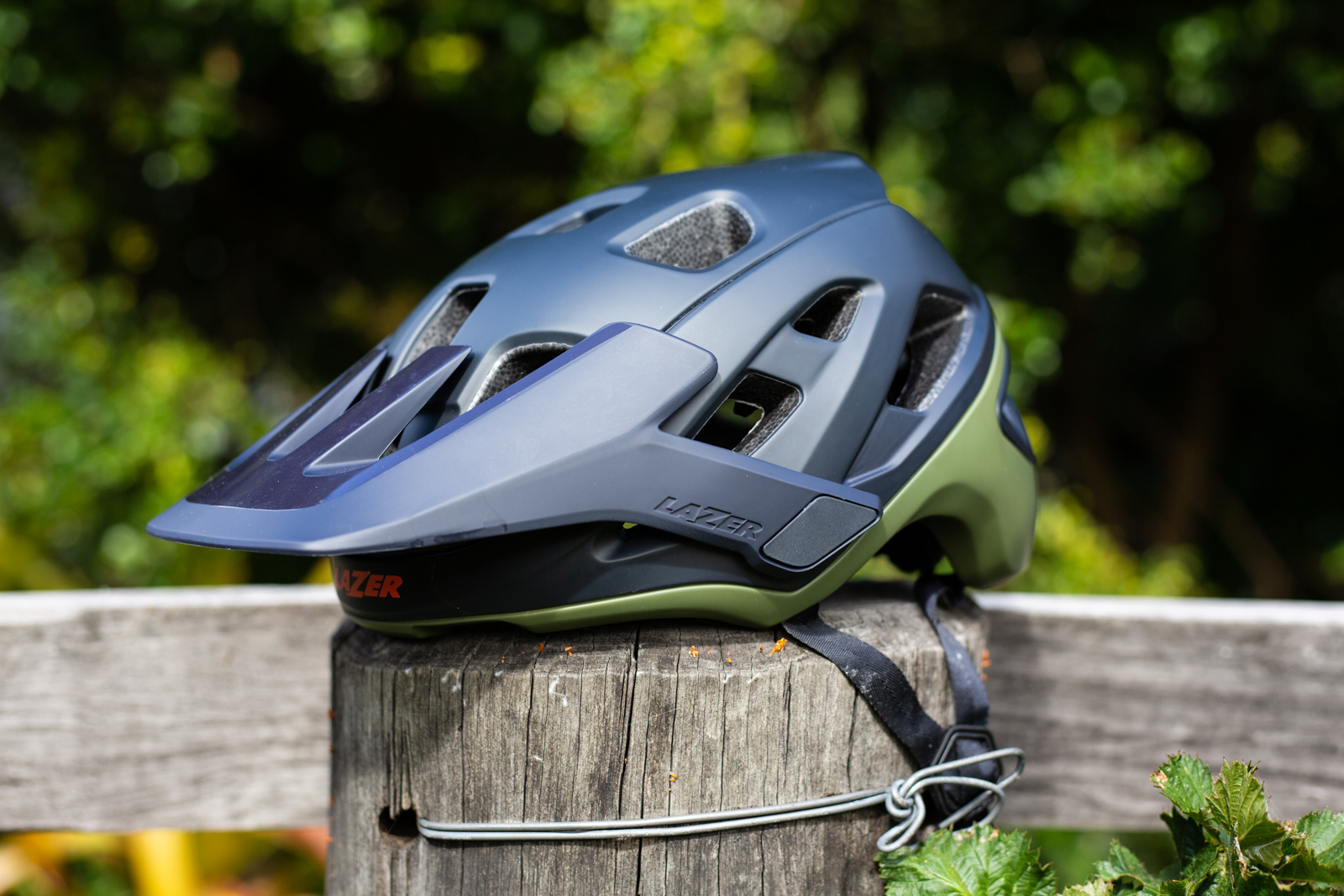
The Lazer Jackal trail helmet has been updated for 2022 with the KinetiCore design, replacing the MIPS slip liner for less weight and greater airflow thanks to all the channels it creates through the crumple zones in the foam. It has extended coverage and an easy to use, highly adjustable retention system. The helmet works well with sunglasses or goggles, with a rubberised gripper to hold a goggle strap in place. You can even park your sunglasses securely under the visor.
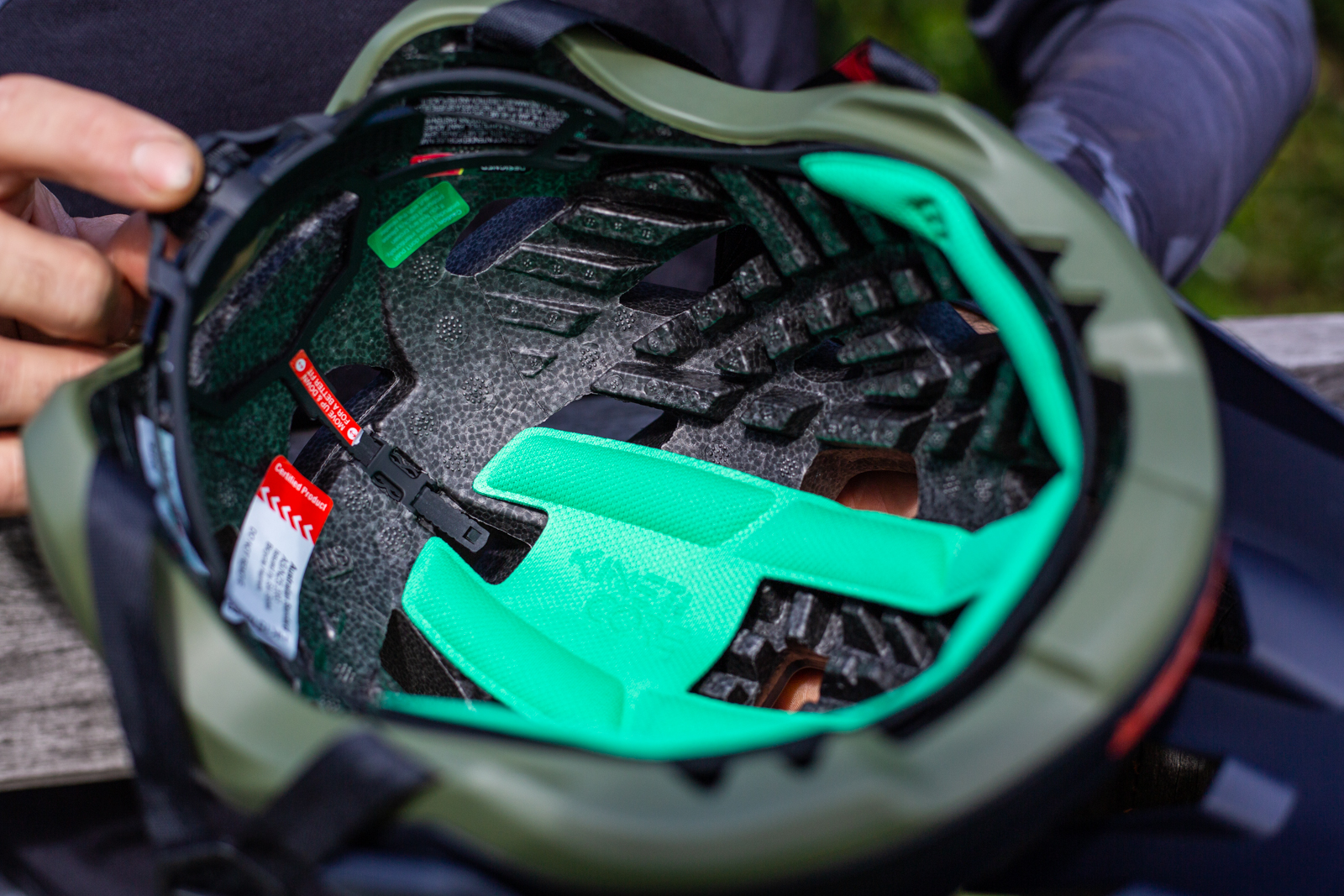
Lazer use high quality straps with easy adjustments. The strap splitters do tend to drift down so keep an eye on them to keep your fit spot on. The straps dry fast and the magnetic buckle is easy to use. On the trail, the ventilation is immediately noticeable compared to other helmets tested, even in the low 20s. The three position visor is well-placed, although some may prefer a more solid click. Still, it stayed in place and easily pushed up when storing your goggles below the visor.
Thanks to the ventilation and therefore comfort, along with excellent coverage and a 5 star Virginia Tech safety rating, this is a very easy helmet to recommend for anyone looking for a trail helmet with great coverage and excellent safety features.
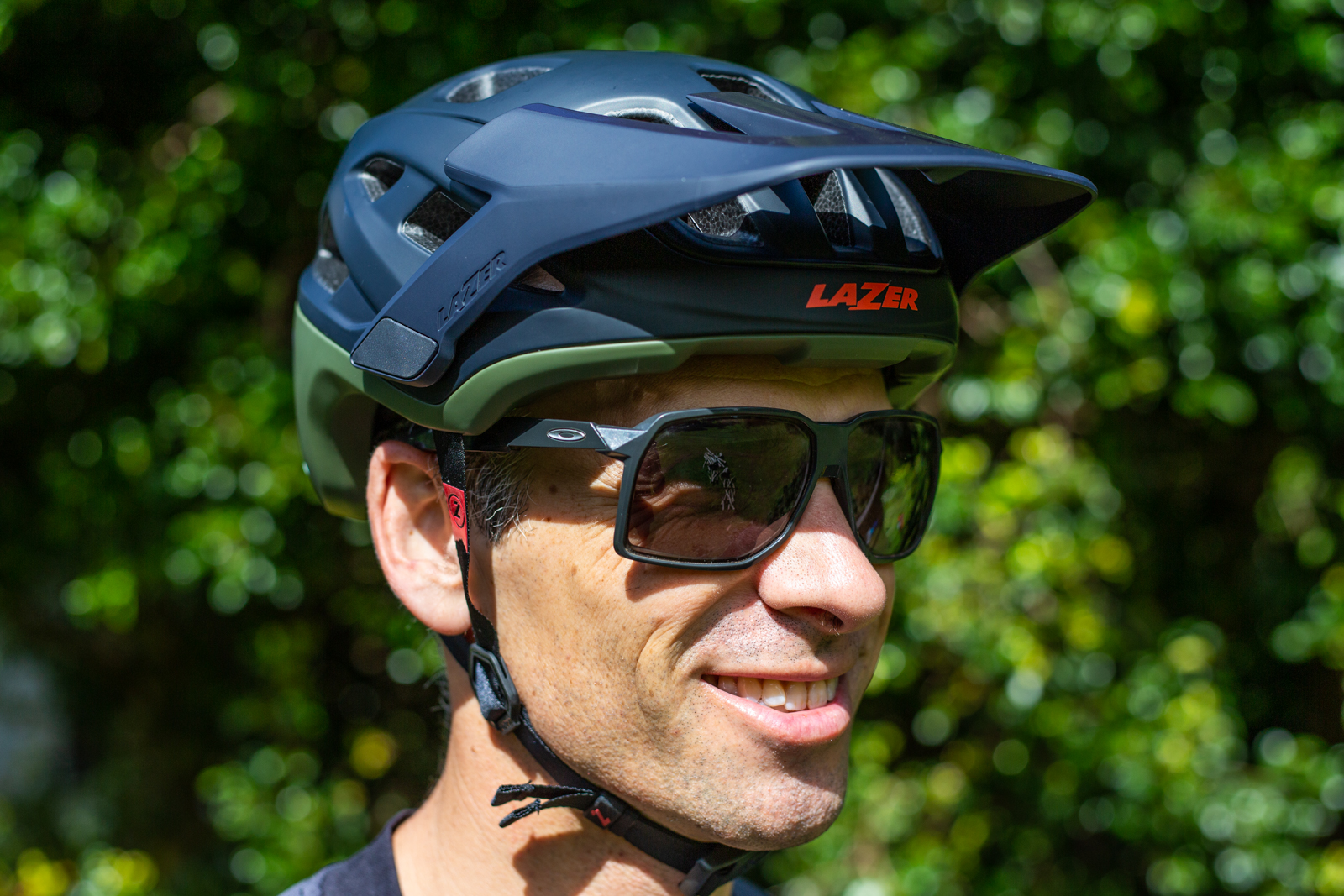
Fox Mainframe
RRP: $139.95
From: Fox Racing Australia
Sizes (tested): S, (M), L
Verified weight: 387g
Rotational impact protection: MIPS
Accessory mount: No
Goggle compatible: No
Ponytail compatible: Not really
Virgina Tech rating: 5 star
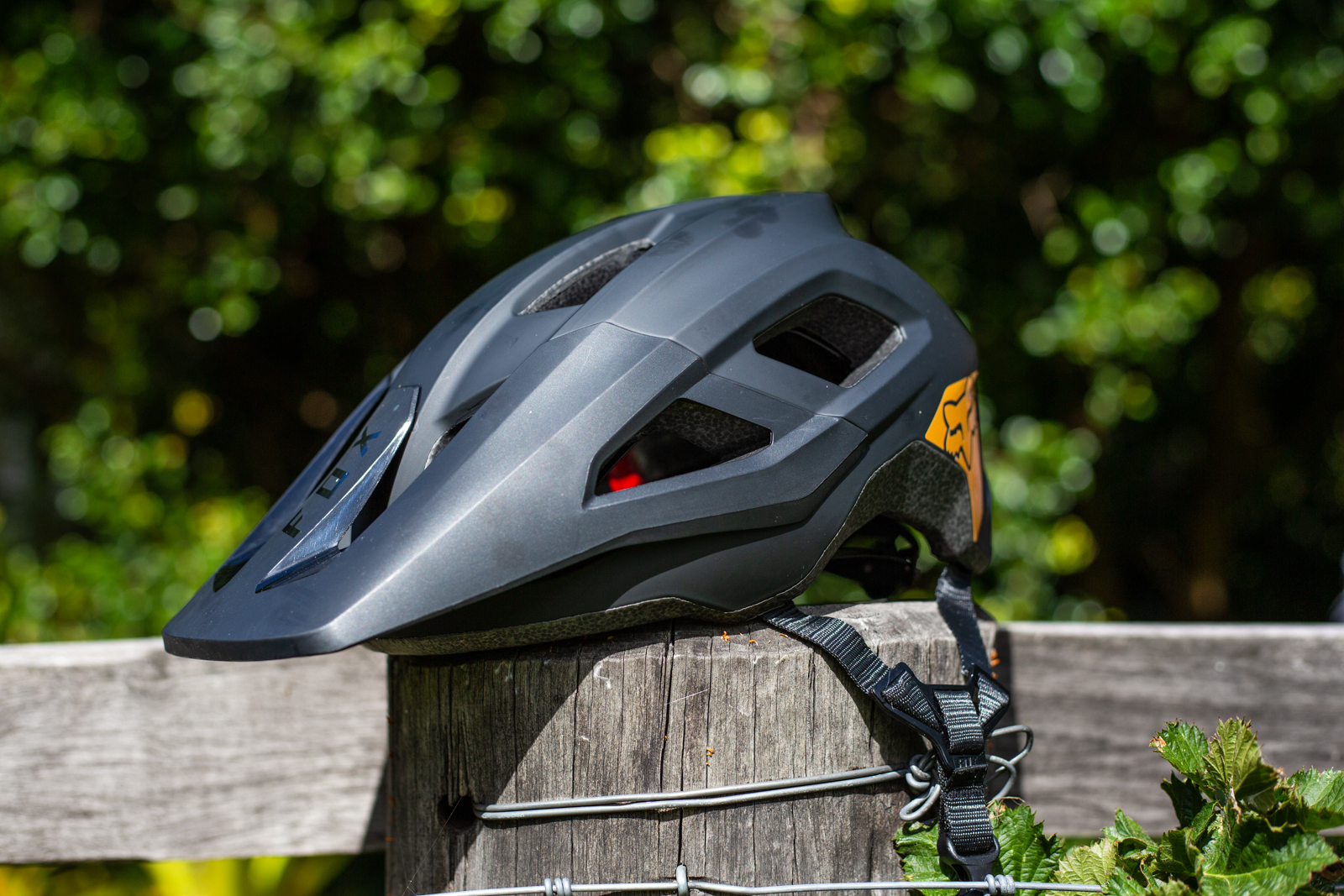
The Fox Mainframe brings the Fox helmet aesthetic to a very competitive price, while still including a MIPS slip liner. The helmet has a fixed position visor and an adjustable retention system alongside generous venting and slightly extended rear coverage. With the vertical adjustment of the retention system sitting in the middle, it means long hair needs to sit very low. The three sizes offer a good fit range and the retention system has four heights to make sure it’s snug. The straps are soft but have limited adjustment at the splitters. The offset buckle is a nice touch for comfort sitting to the side of your throat. The padding is light and keeps the MIPS away from your hair at the front of the helmet.

On the trail, the Mainframe a very stable helmet with good ventilation. The fixed visor means you cannot park a set of goggles underneath it, and it can get in the way if you tend to ride trails with a lot of V-ditches or steep transitions. I found myself needing to crane my neck further to see past the visor. The softer straps do tend to hold sweat a little longer than some.
The shell doesn’t wrap over the lower edge so it does leave the EPS foam vulnerable to knocks and damage. Regardless, this is a high value helmet with a great safety rating that is worth trying on for most trail riders. It’s great to see a a helmet at this price with MIPS, and in a good size and colour range as well.

Bontrager Blaze WaveCel
RRP: $349.99
From: Trek Australia
Sizes (tested): S, (M), L
Verified weight: 437g
Rotational impact protection: WaveCel
Accessory mount: Yes
Goggle compatible: Yes
Ponytail compatible: Yes
Virgina Tech Rating: 5 star
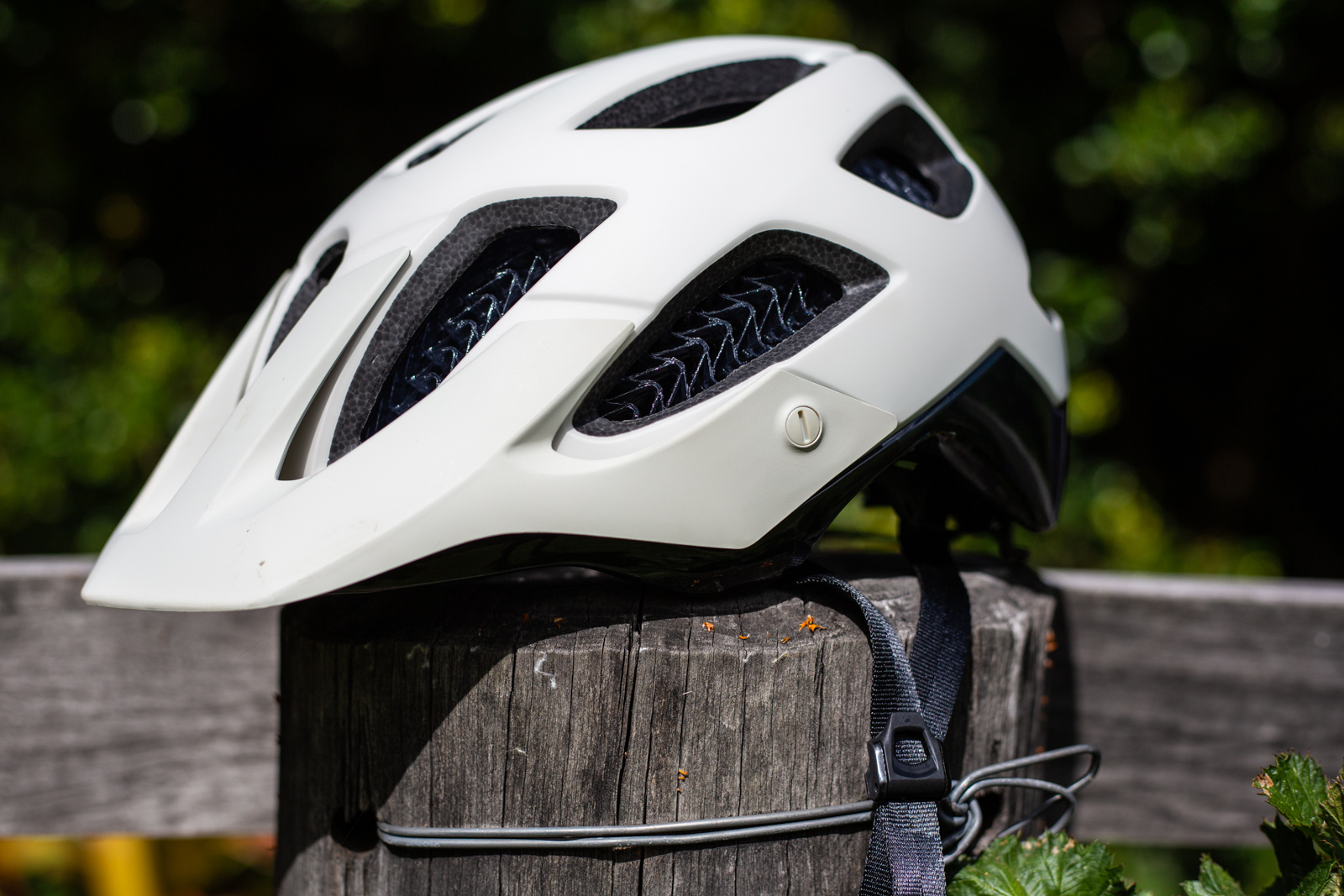
The Bontrager Blaze was one of the first helmets with their WaveCel protection, which claimed to have even better protection against concussion than a MIPS liner does. The WaveCel is the visible wavey cell structure, replacing some of the EPS foam. It can limit airflow for some and this is more noticeable at low speeds. The straps have a solid feel and don’t hold much sweat, and the magnetic buckle is a nice touch. A 3 position visor can sit high enough to store goggles beneath it, and the back of the helmet has a notch to prevent a goggle strap slipping. The Blaze sits low near the temples, but not as low as the TLD A3 in the back. The shell sits very close to my sunglasses so it’s worth checking for your own pair. The Blaze comes with a nifty accessory mount which is held in place magnetically – and so it will move out of the way in a crash instead of crushing your skull!
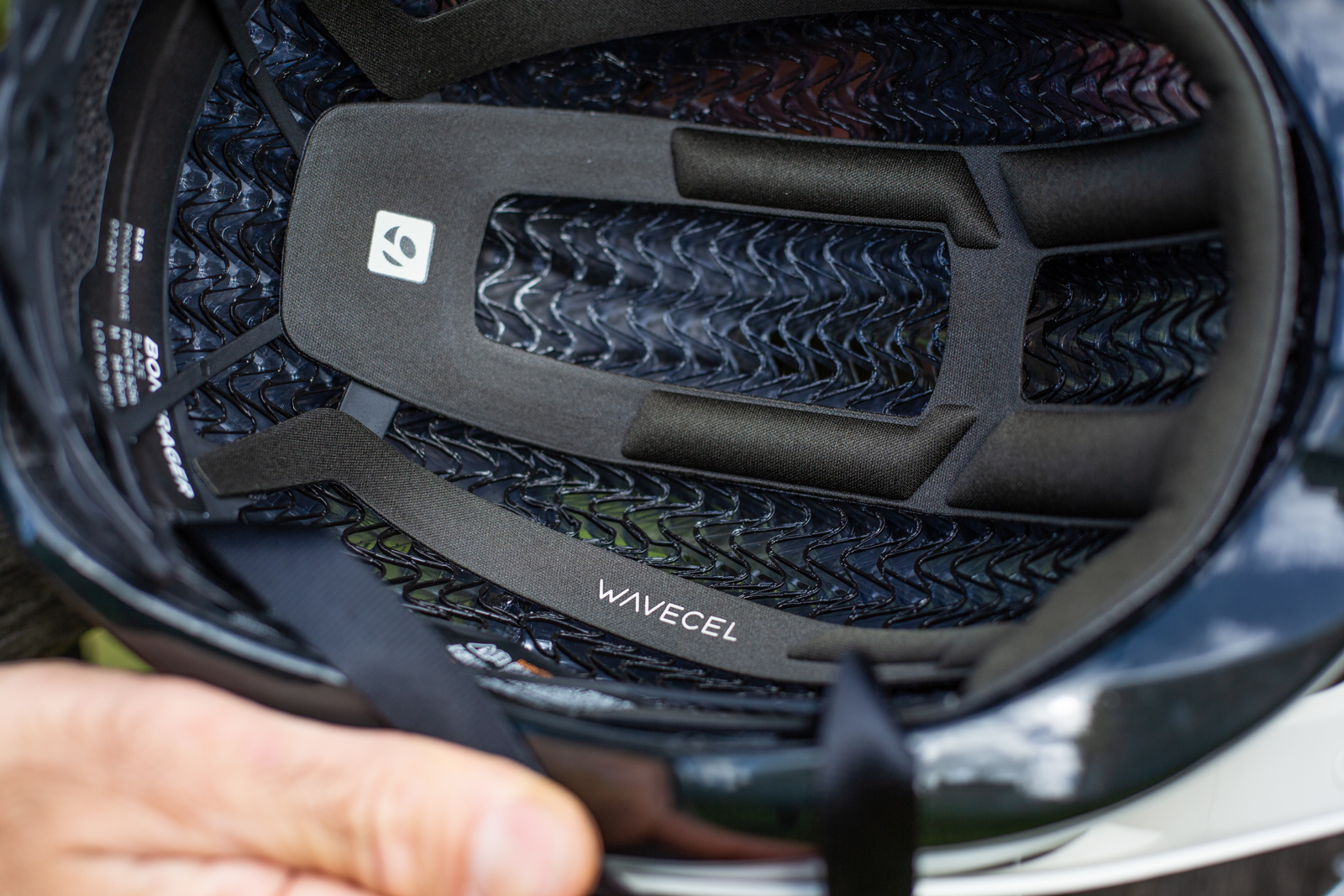
On the trail the Blaze is a very stable and comfortable fit. However, in warmer weather it is noticeably a hot helmet, and yes you do notice the extra weight. The padding has excellent coverage and absorbs sweat and can be replaced – or washed. This helmet is exquisitely produced and has excellent features, fit and comfort – but is likely best suited to south of the subtropics, or use outside the height of summer.
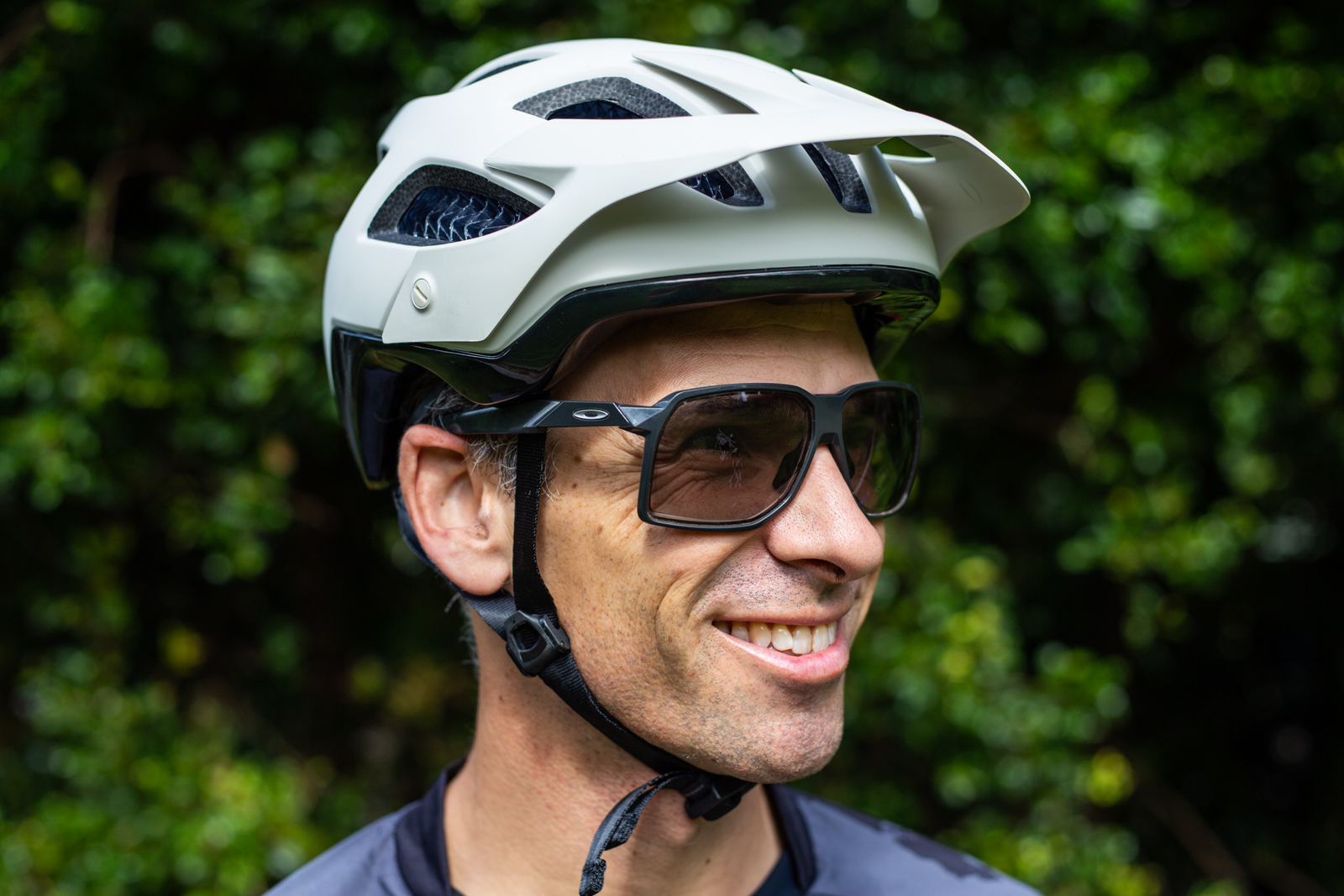
Bontrager Rally WaveCel
RRP: $229.99
From: Trek Australia
Sizes (tested): S, (M), L
Verified weight: 390g
Rotational impact protection: WaveCel
Accessory mount: No
Goggle compatible: Yes
Ponytail compatible: Yes
Virgina Tech Rating: 5 Star
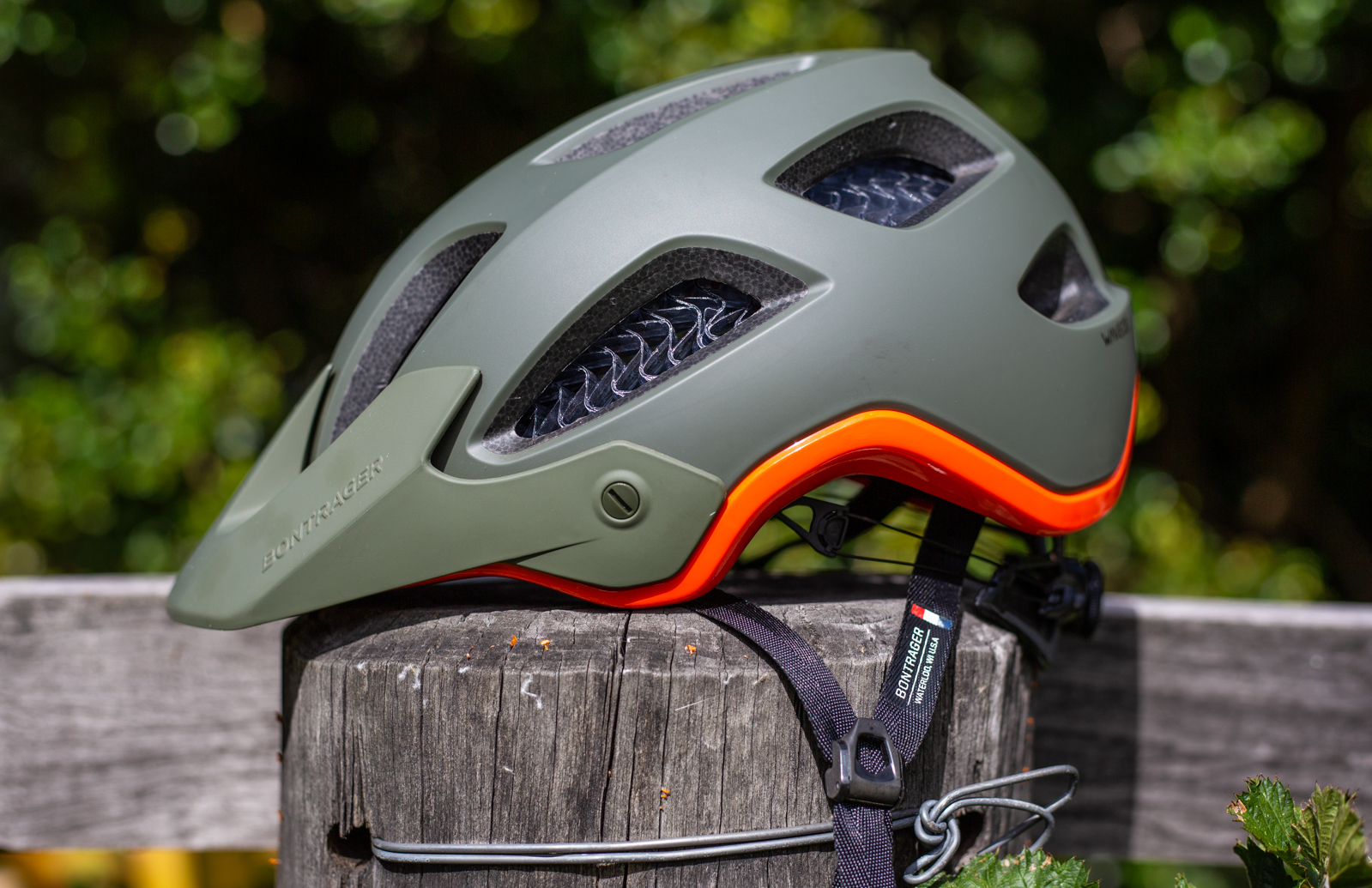
The Bontrager Rally shares many of the features of the Blaze, but is substantially cheaper. The amount of WaveCel is reduced, prioritising the front 70% of the helmet. The visor works the same and the coverage is also the same for the helmet. The rear ports are smaller on the Rally, and it doesn’t come with the accessory mount of the Blaze – nor is it compatible with it.
In general, achieving a good fit is the same, although the strap uses a regular buckle and slightly thinner straps that still dry fast.

The padding is a little simpler but very comfortable. When riding, it’s a solid feeling stable helmet, but I did find it runs a tiny bit warmer than the Blaze, most likely as there is a small difference in heat being able to escape. It also did make contact with my eyewear if I didn’t have it sitting just right. Like the Blaze, the warmth of the helmet disappears on fast descents, but is readily apparent slogging up hills on warm days. But like the Blaze this is a very well-made helmet with lots of adjustment for a secure fit – still likely best for those not in Australia’s hottest regions.
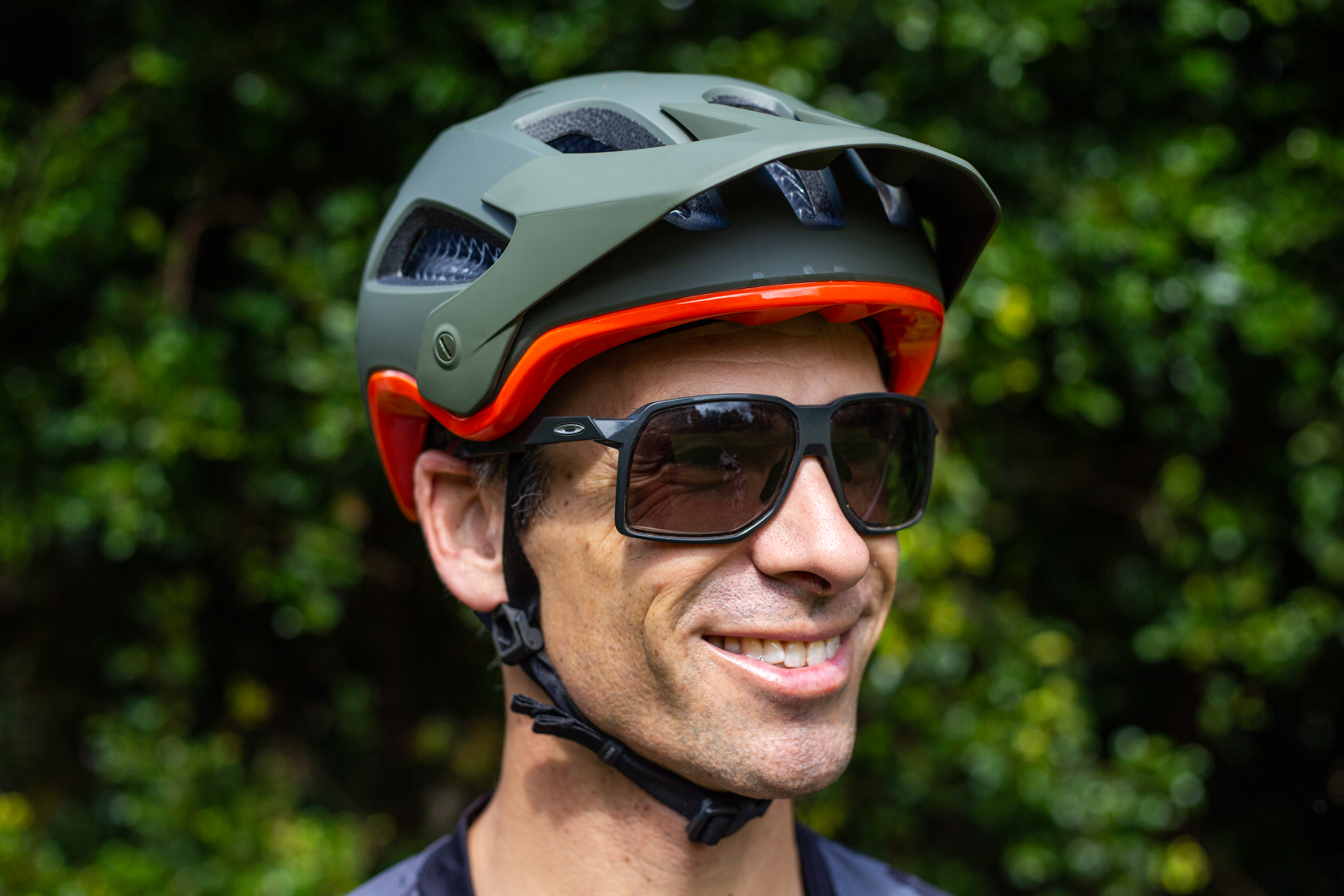
100 Percent Altis
RRP: $189.99
From: FE Sports
Sizes (tested): XS/S, (S/M), L/XL
Verified weight: 365g
Rotational impact protection: Smartshock
Accessory mount: No
Goggle compatible: Yes
Ponytail compatible: Yes
Virgina Tech Rating: N/A
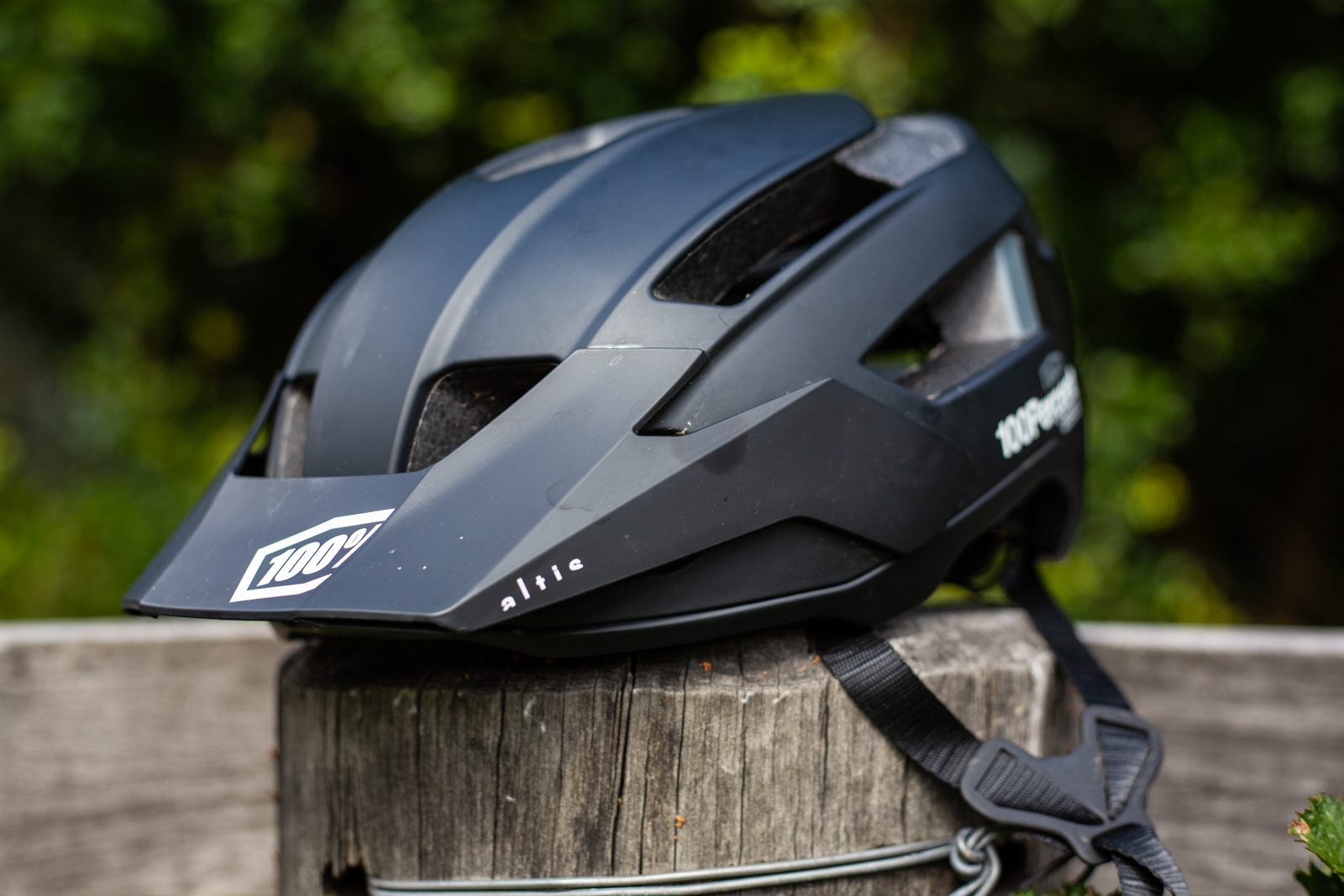
100 Percent have a wide range of clothing and protection, and their trail helmets are a popular part of the range. The 100 Percent Altis has full shell coverage and whopping great vents along with a solid 3-position visor. 100 Percent use the Smartshock 11-point rotational liner. It’s a series of rubber grommets that attach the helmet liner into the shell, said to assist in adding rotational movement to dissipate force than just the shell and EPS foam against your skull.
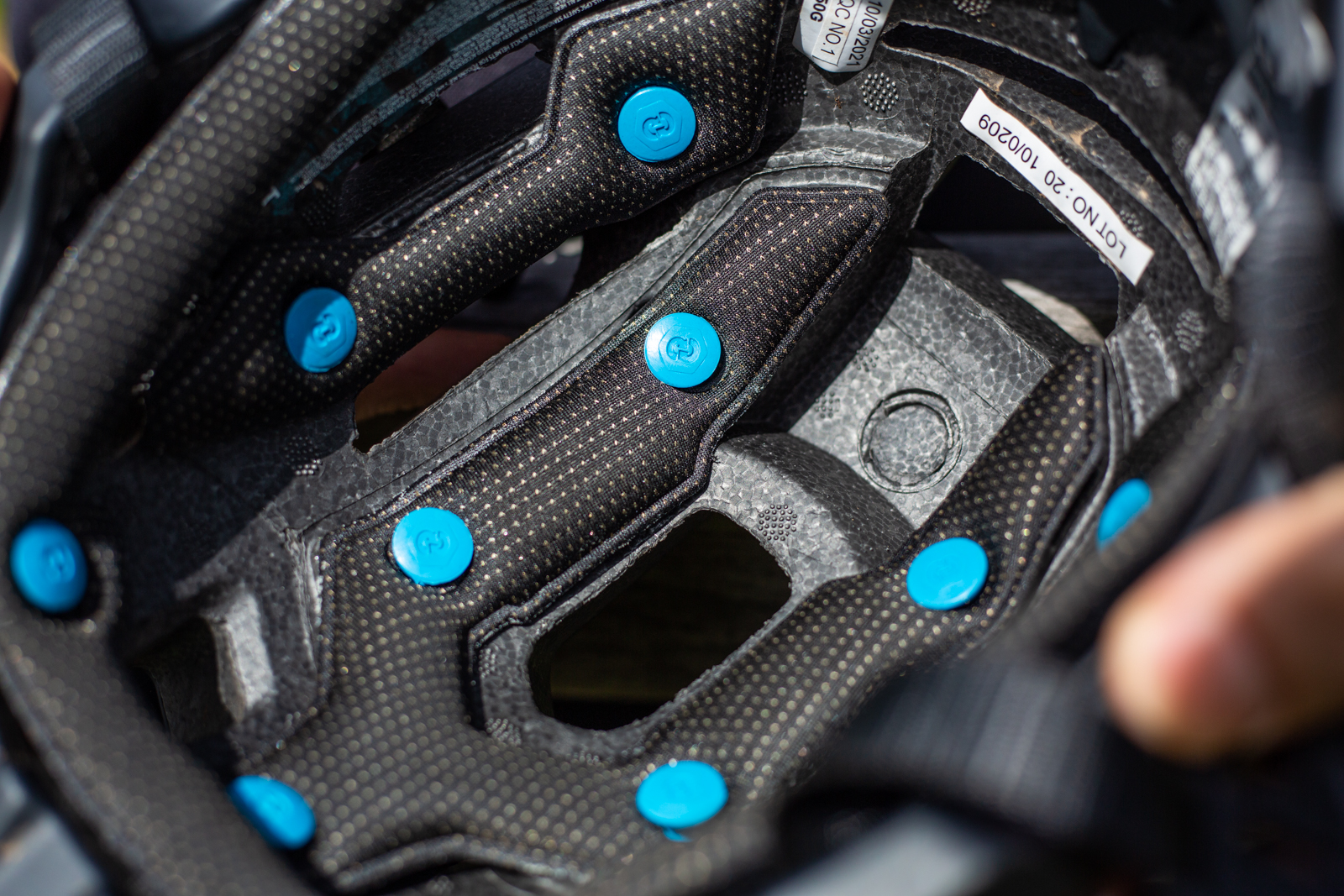
The fit is good, although the depth of the helmet isn’t the same as some, notably the TLD A3 and Specialized Ambush 2. Like any helmet, try it on for fit. The retention system doesn’t have height adjustment so getting the perfect fit may not be possible. Still, the shell has a secure fit and straps and splitters work well to get the fit right. The buckle is offset to your left.
On the trail it is stable, with a bit of movement possibly thanks to the Smartshock. The elastomers may interfere with your hair or head shape, so it is worth trying one on. But overall this is an airy, comfortable helmet which has all the right style cues for many.
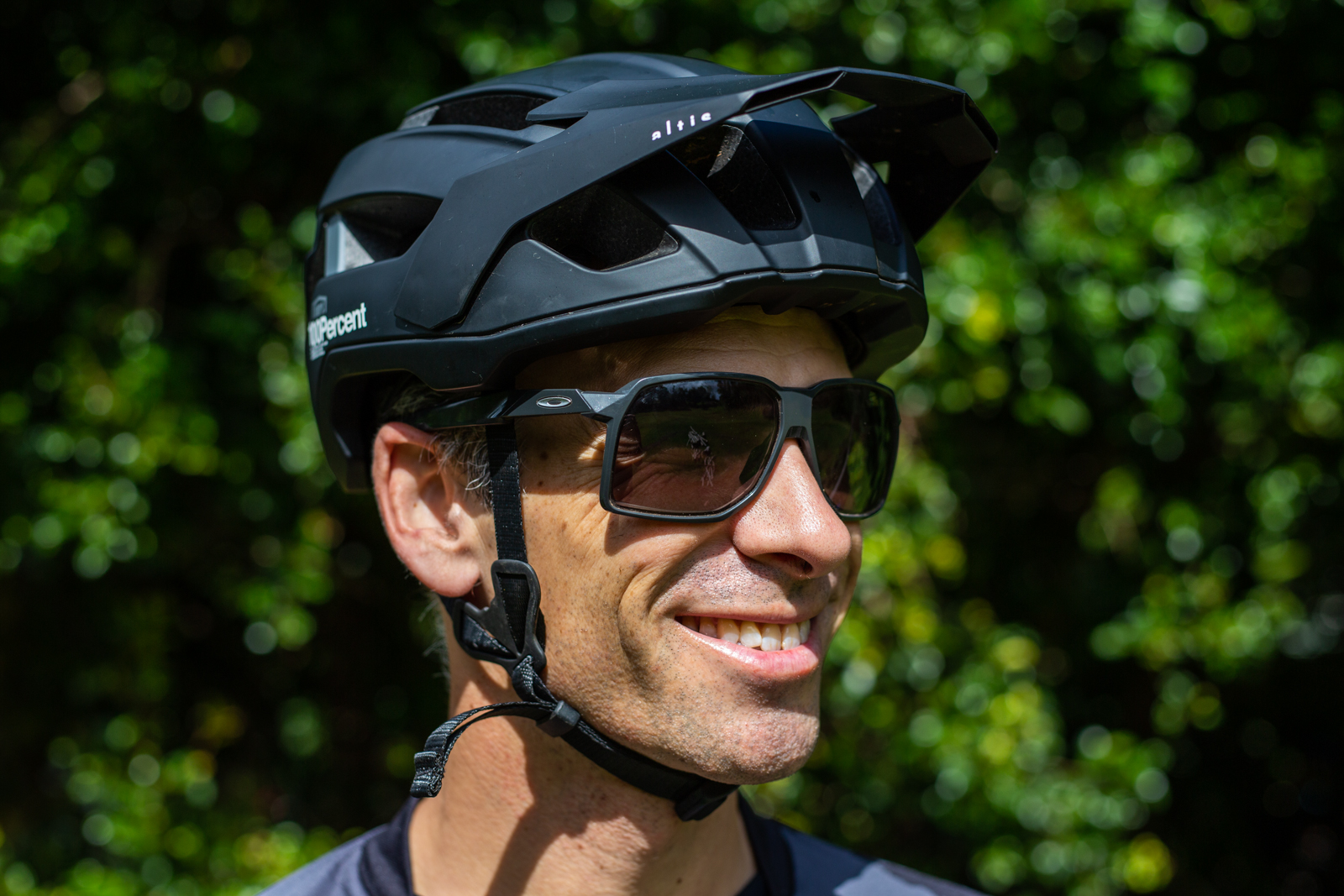
Troy Lee Designs A3 MIPS
RRP: $444.95
From: Lusty Industries
Sizes (tested): XS/S, (M/L), XL/2XL
Verified weight: 412g
Rotational impact protection: MIPS
Accessory mount: No
Goggle compatible: Yes
Ponytail compatible: Not really
Virginia Tech Rating: 5 star
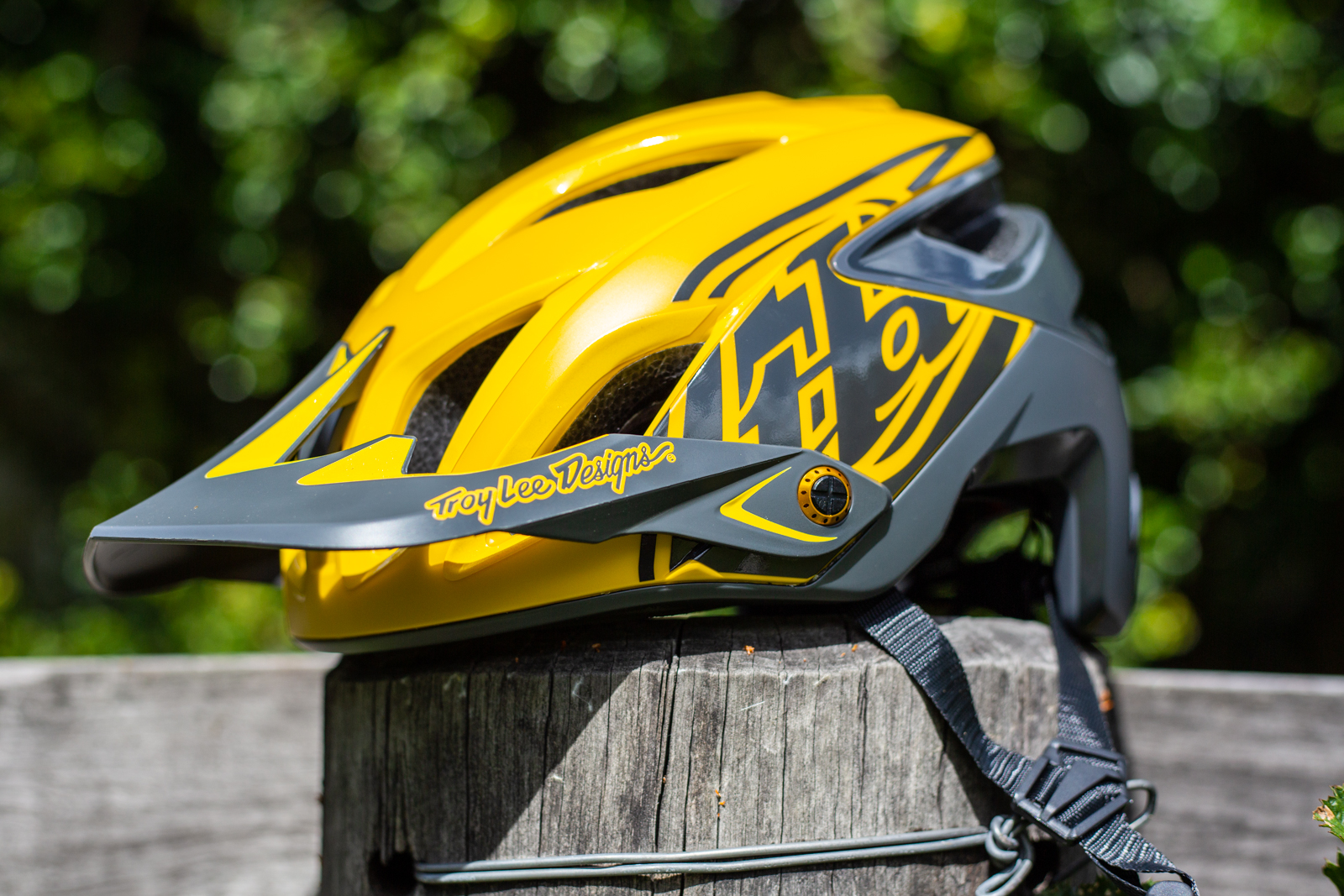
Troy Lee Designs have been making iconic helmets since I started riding in the mid 1990s. The TLD A3 MIPS is one of their latest models, with the deepest coverage of any helmet in this test. It’s a solid feeling helmet and very secure once fitted. The MIPS liner has complete coverage and even adapts with the retention system. The visor has 3-positive positions but can push far higher for goggle storage. The straps use splitters that don’t budge and the material dries fast. The buckle is magnetic and offset for ease of use and comfort. With lots of pad contact and a 3 position heigh adjustable retention system, this was hands down the most secure feeling helmet on test.
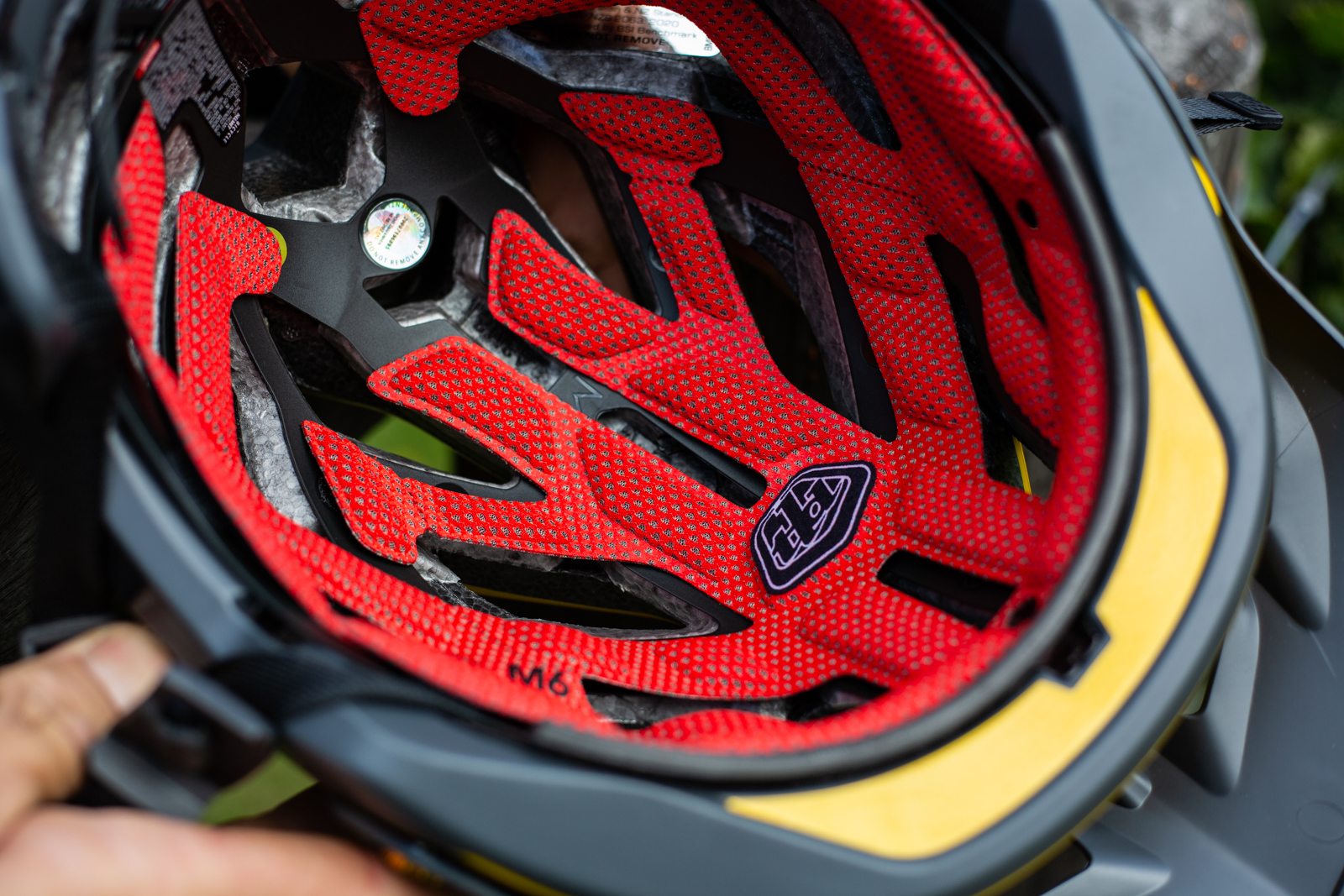
When riding, that feeling continued. The helmet didn’t move around, and while the coverage did mean it was a little warm, the tricky rubber strip above the brow keeps excess sweat from dripping into your eyes. Despite feeling like it sat really low on my head, I had no eyewear interference. The A3 just sat solid and in the background. Given the extra protection in the back I would certainly recommend this to anyone who wants to ensure they have plenty of coverage. TLD have their own style, and it’s up to you whether it’s yours or not.
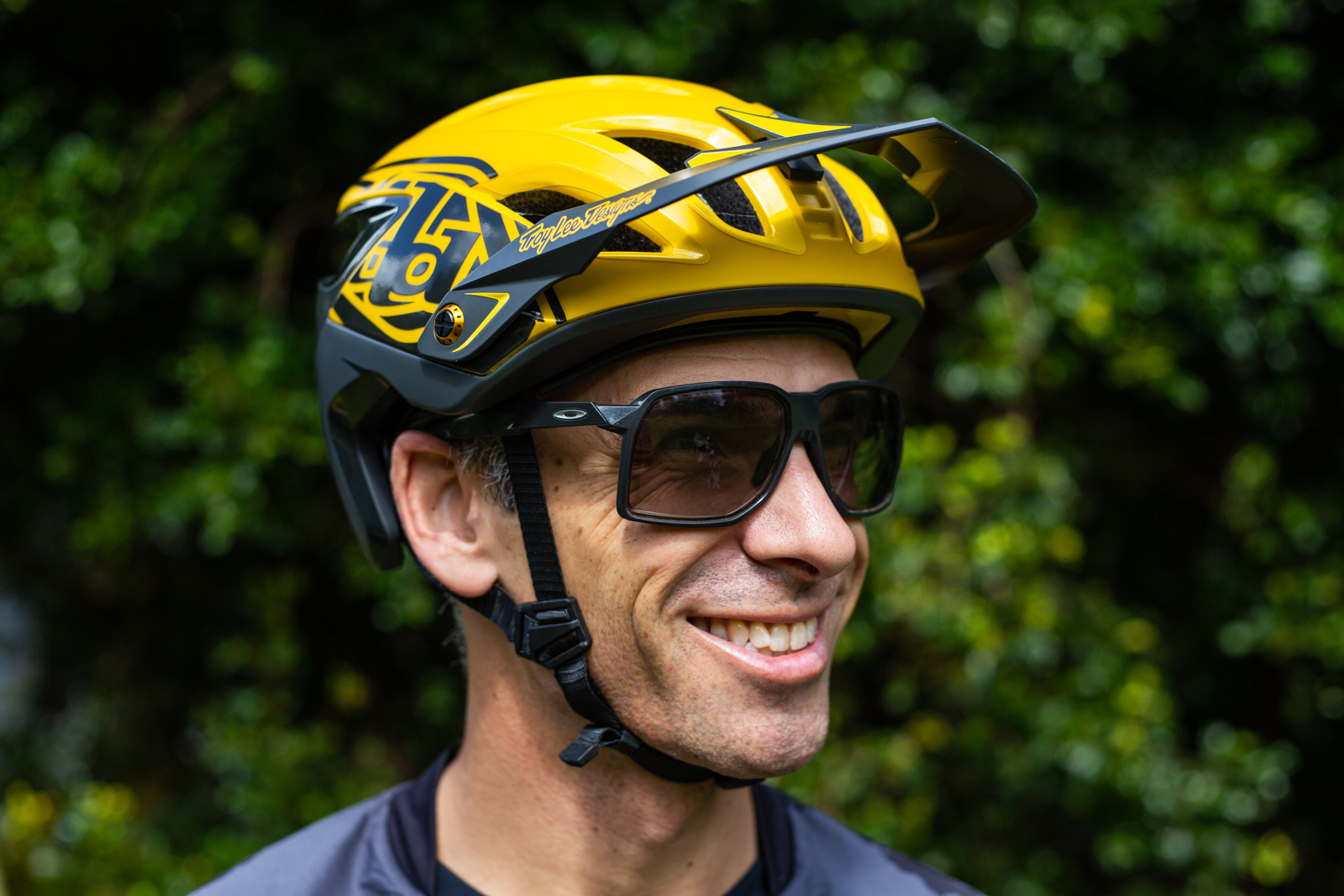
MET Echo
RRP: $109.95
From: Met Helmets
Sizes (tested): (S/M), M/L, L/XL
Verified weight: 280g
Rotational impact protection: No
Accessory mount: No
Goggle compatible: No
Ponytail compatible: Not really
Virginia Tech Rating: N/A
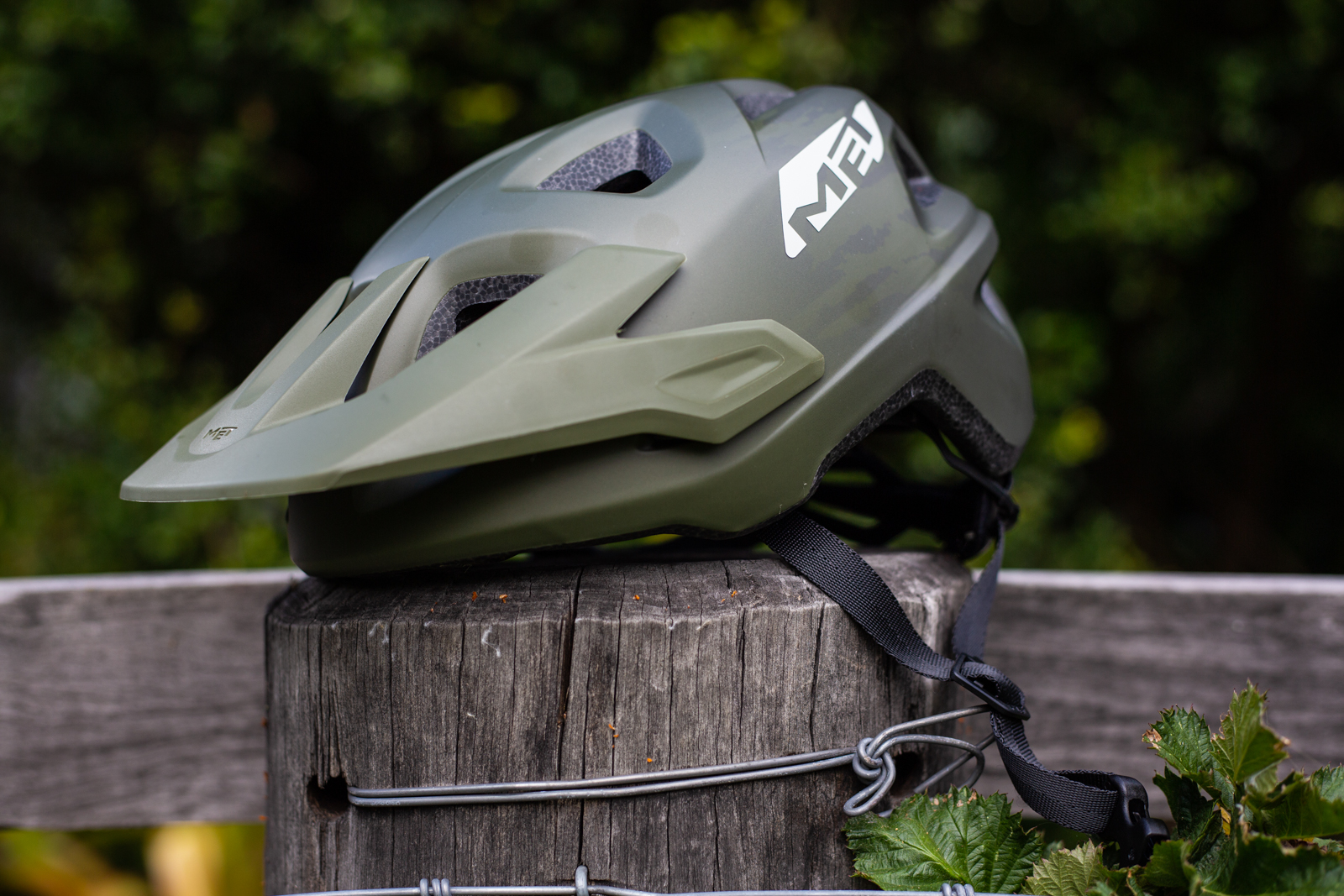
The MET Echo is the lightest and cheapest helmet on test, although there is a MIPS model also available for a little more. The vents are a little less generous than on a pricier helmet and the basic channels on the inside mean air does move over your head. The fixed position visor limits eyewear storage but is small enough to not move into your vision. The retention system can be pulled lower to really keep the helmet secure, but it’s not a permanent setting. It does stay snug though. The good quality straps and splitters allow for a precise fit with the buckle. The shell coverage doesn’t wrap over the edge, like the Fox Mainframe, leaving it open to damage from every day knocks and bumps.
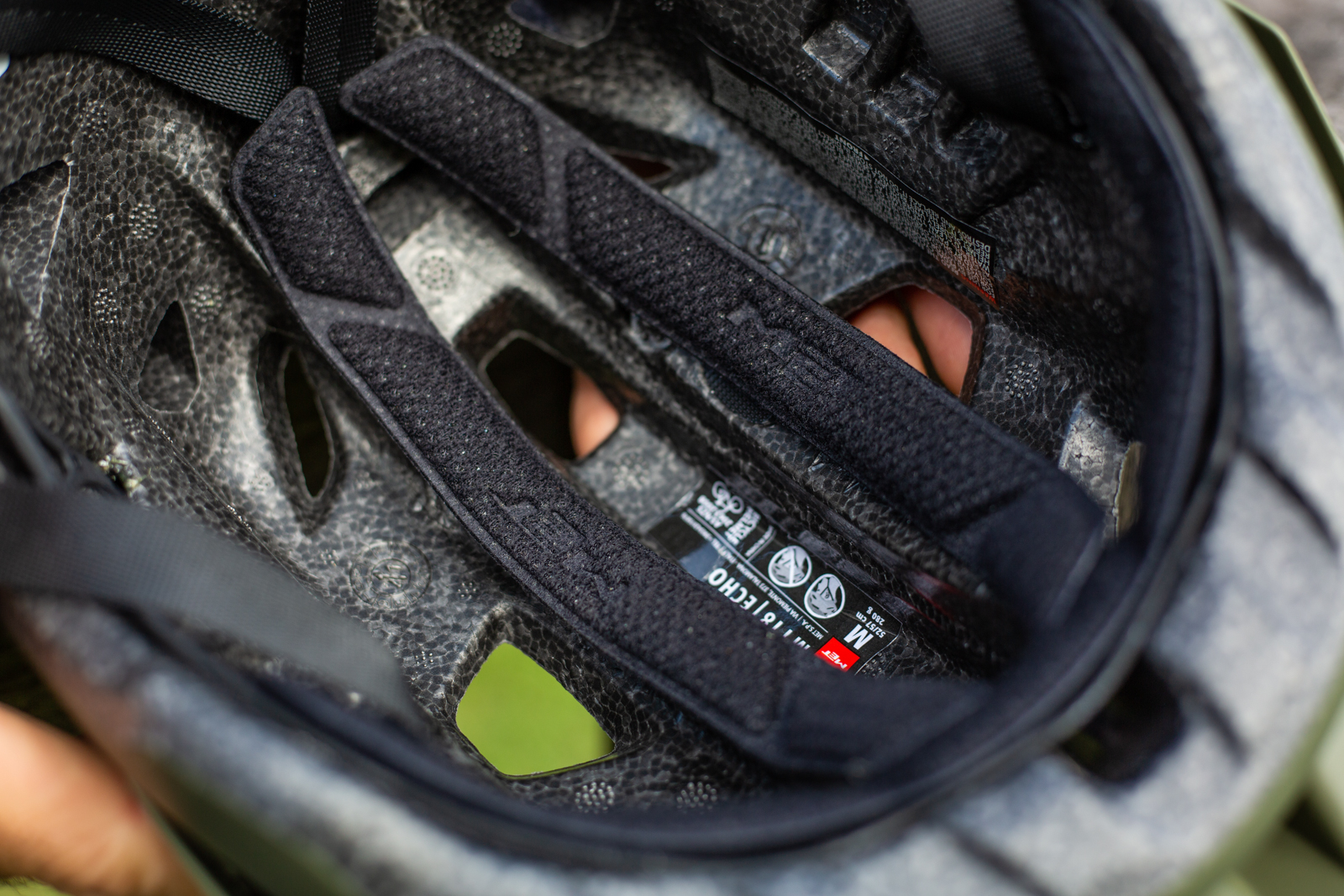
The Echo doesn’t fit nearly as low as some other helmets on test, and the basic visor does make it look like the cheapest helmet. But – it works! On the bike it is noticeably a light helmet and the ventilation is acceptable. The smaller shell size was a little off-putting. I could have gone up a size for a deeper fit, but the shell may have been too big. I think this is a great price point for a casual trail helmet – but if you’re after the most coverage I’d suggest spending more and looking elsewhere.
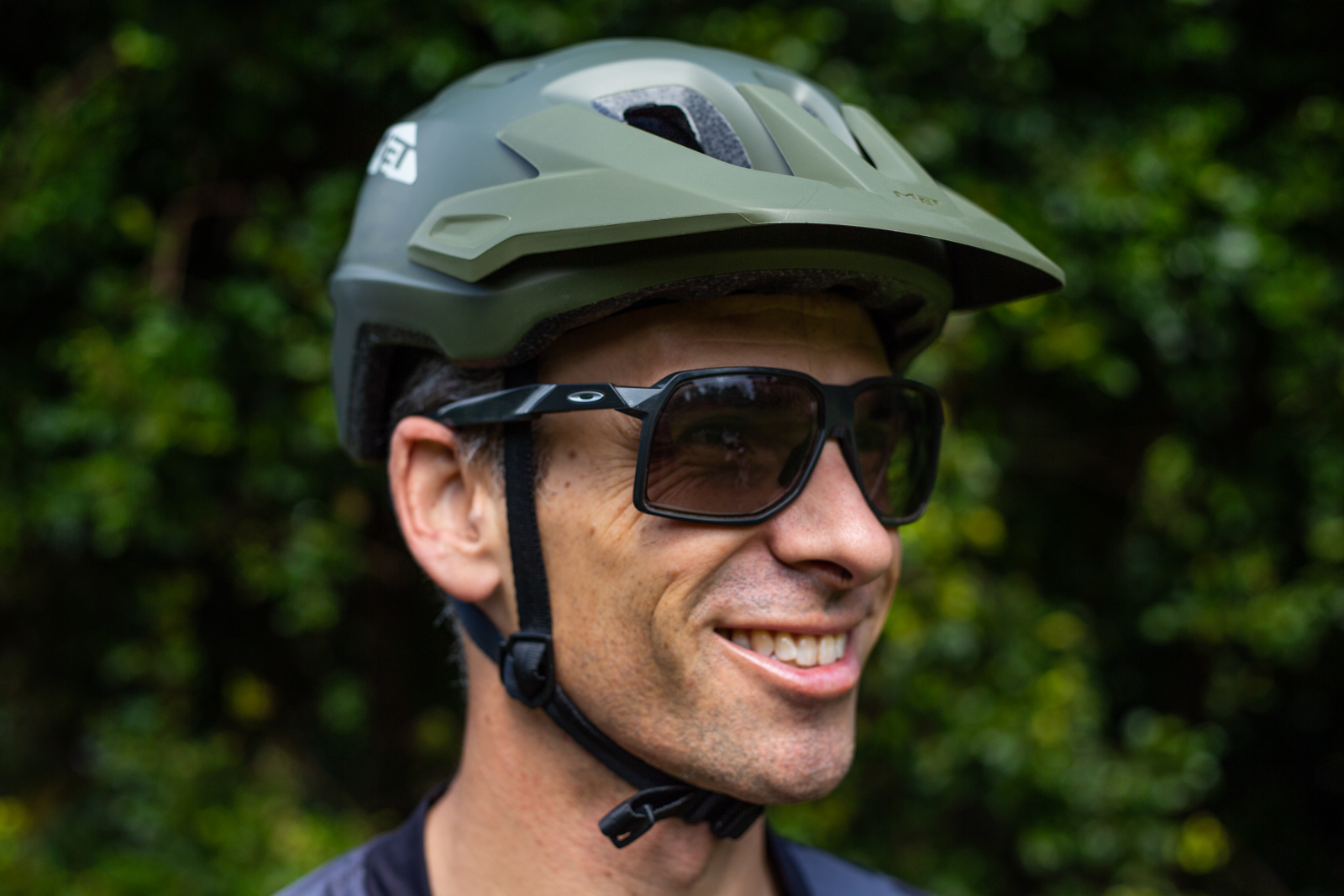
Specialized Ambush 2
RRP: $280
From: Specialized
Sizes (tested): S, (M), L
Verified weight: 355g
Rotational impact protection: MIPS
Accessory mount: No
Goggle compatible: Yes
Ponytail compatible: Not really
Virgina Tech Rating: 5 star
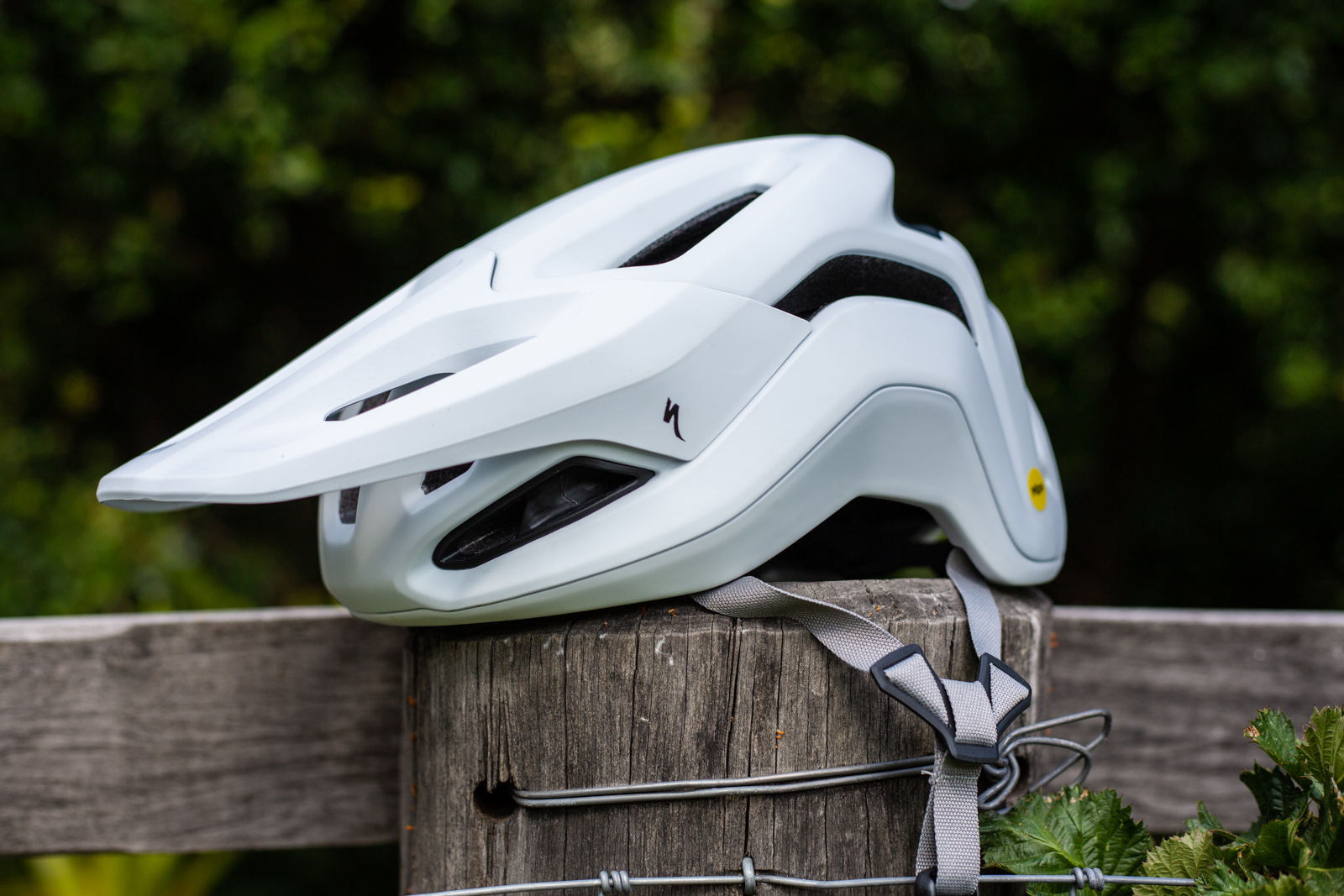
The Specialized Ambush 2 brings an all-new look to the model, and part of me wanted to hate it. It looked bulky, with a fixed visor that would surely be in the wrong position. I couldn’t have been more wrong. The helmet sits low at the brow, temples and back of your head giving exceptional coverage, and with dual density EVA foam it’s a great weight while offering a 5-star safety rating. The vents under the visor channel over your head so it’s also far cooler than it looks. The straps and splitters are high quality, and the retention system can adjust vertically for a precise fit.
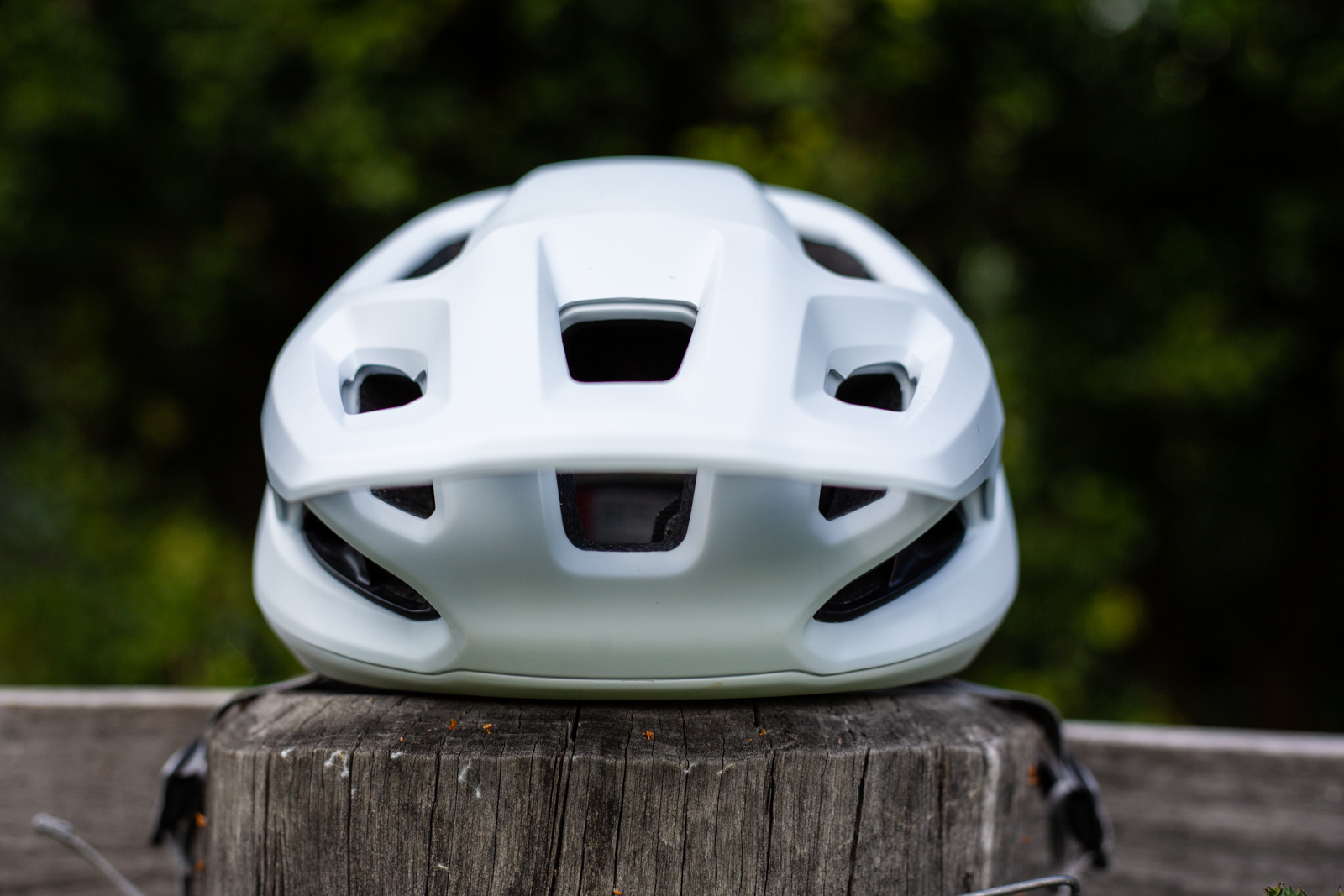
Specialized added sunglasses storage, and even my Coke bottle prescription shades fit – plus goggles have plenty of room. I never felt the need to adjust the visor up like on the Fox Mainframe, but maybe a little lower at times would be nice – although rare.
On the trail it is incredibly stable, feels lighter than it looks and is well-vented. The pad contact is excellent and it’s a comfortable and secure fit. Specialized have done a great job bringing this in under $300 – it’s worth a look for any trail rider wanting a high value, high coverage, well-ventilated helmet.
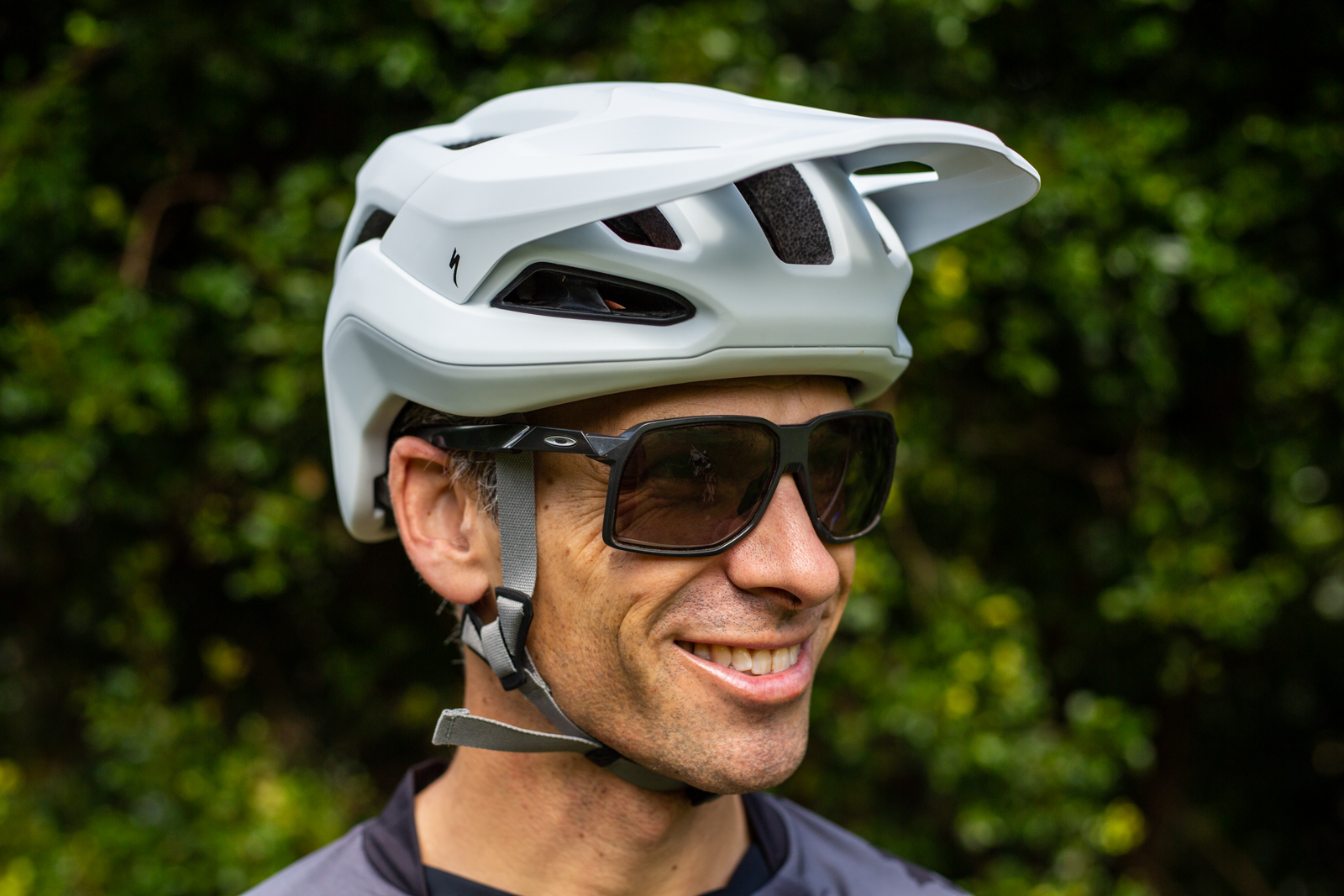
Specialized Camber
RRP: $120
From: Specialized
Sizes (tested): XS, S, (M), L, XL
Verified weight: 364g
Rotational impact protection: MIPS
Accessory mount: No
Goggle compatible: Yes
Ponytail compatible: Not really
Virginia Tech Rating: 5 star
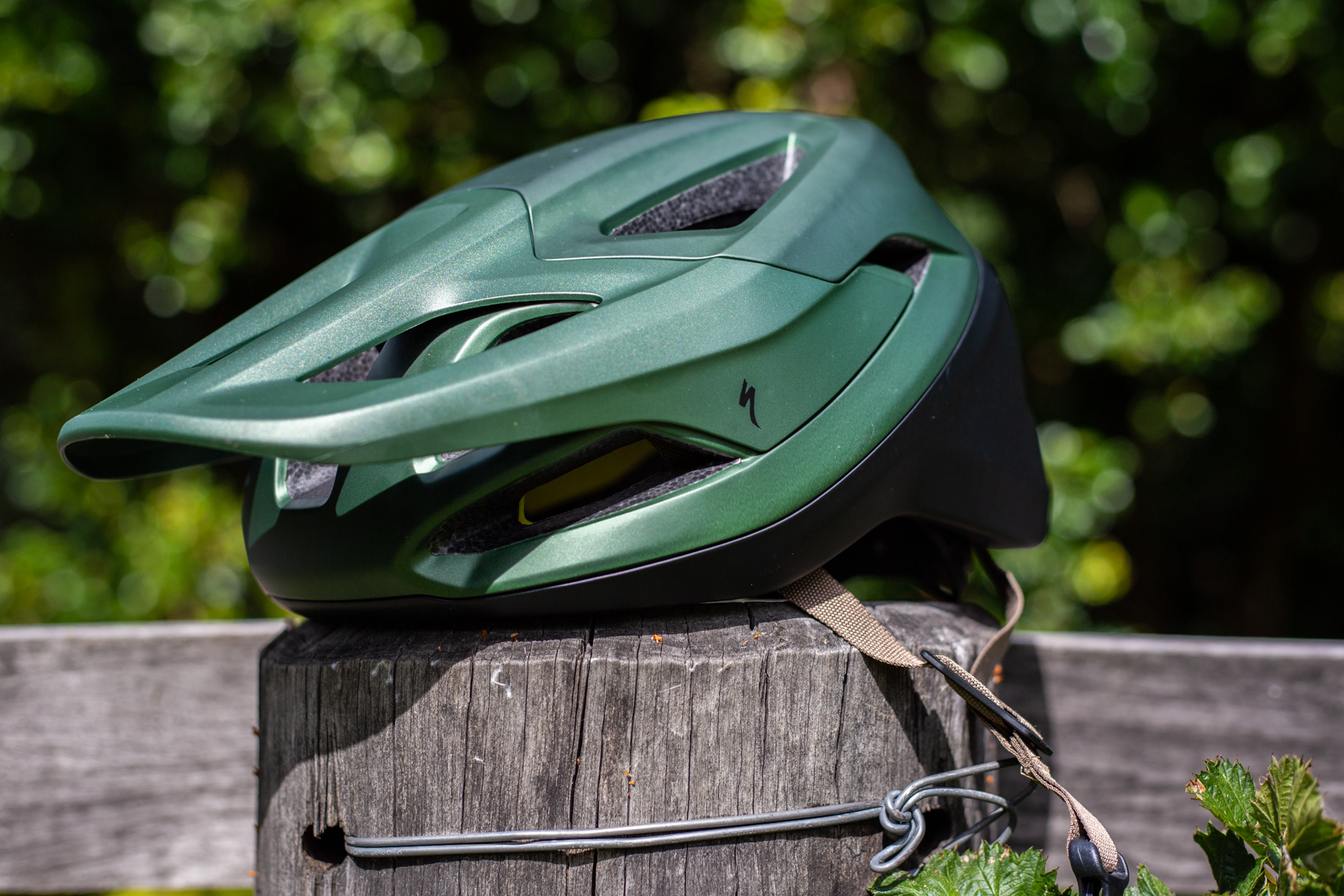
The Specialized Camber is the lowest price MIPS equipped helmet on test, and it comes in a whopping 5 size options! It also has full shell coverage of the EPS foam unlike others at this price point. The Camber has a high fixed visor and the high quality straps and buckle simple splitter without much option to adjust how the yokes sit below your ears. The retention system lacks complete vertical adjustment. Goggles and sunglasses fit fine, but the snazzy sunglasses port of the Ambush isn’t here. The MIPS system has a lot of coverage but not as much padding coverage, and the single density EVA foam has far less channeling for air flow. The shell doesn’t offer as much coverage in the rear as the Ambush 2.
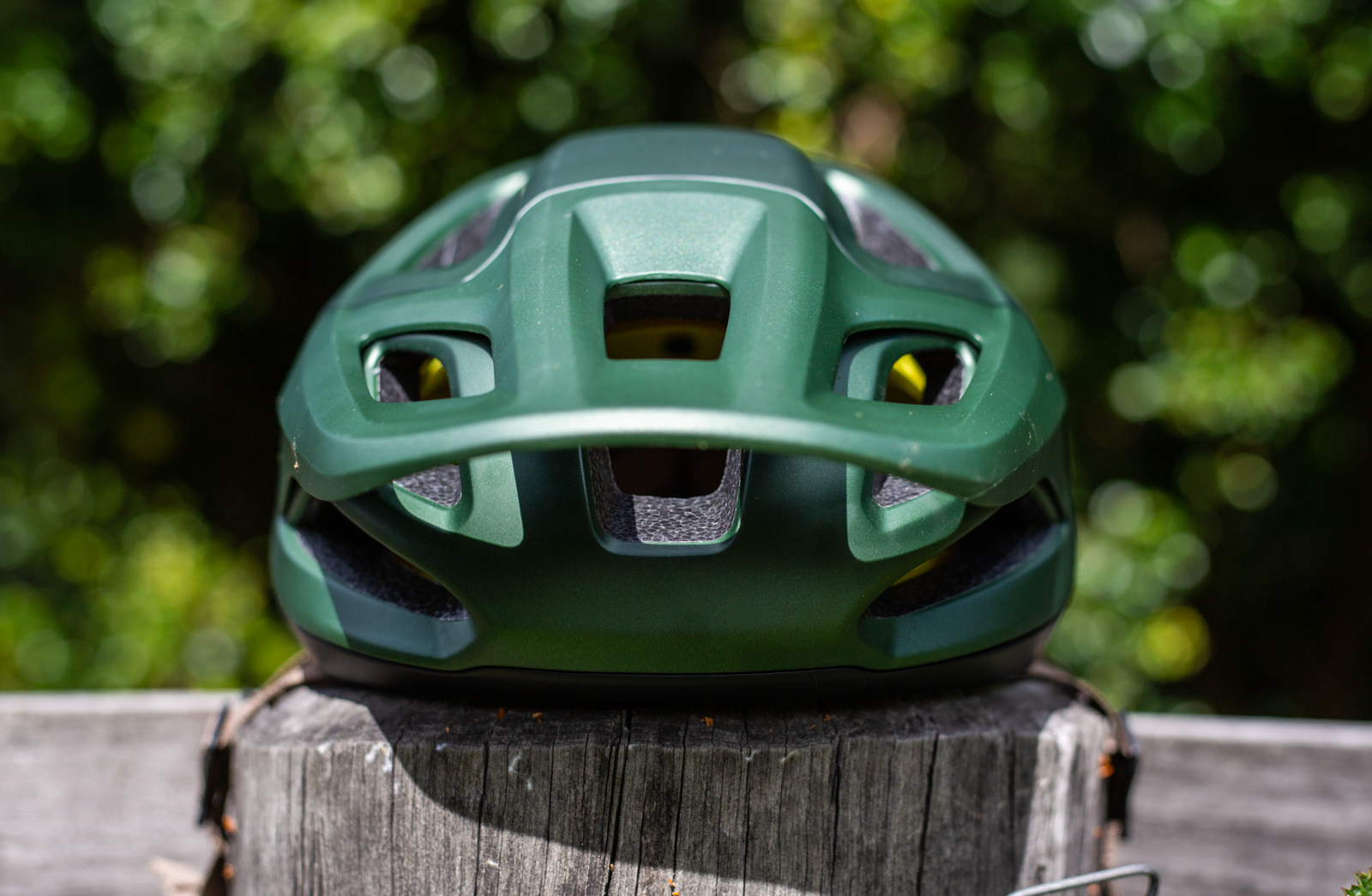
On the trail this is really stable and quite well-vented. The visor is better placed than the MET Echo or Fox Mainframe, and overall this is a better finished helmet for that pricepoint. Add in the fact there are five sizes available and it’s a sharply priced helmet to look at for a lot of riders. Greater comfort, coverage and cooling comes with a step up to the Ambush 2.
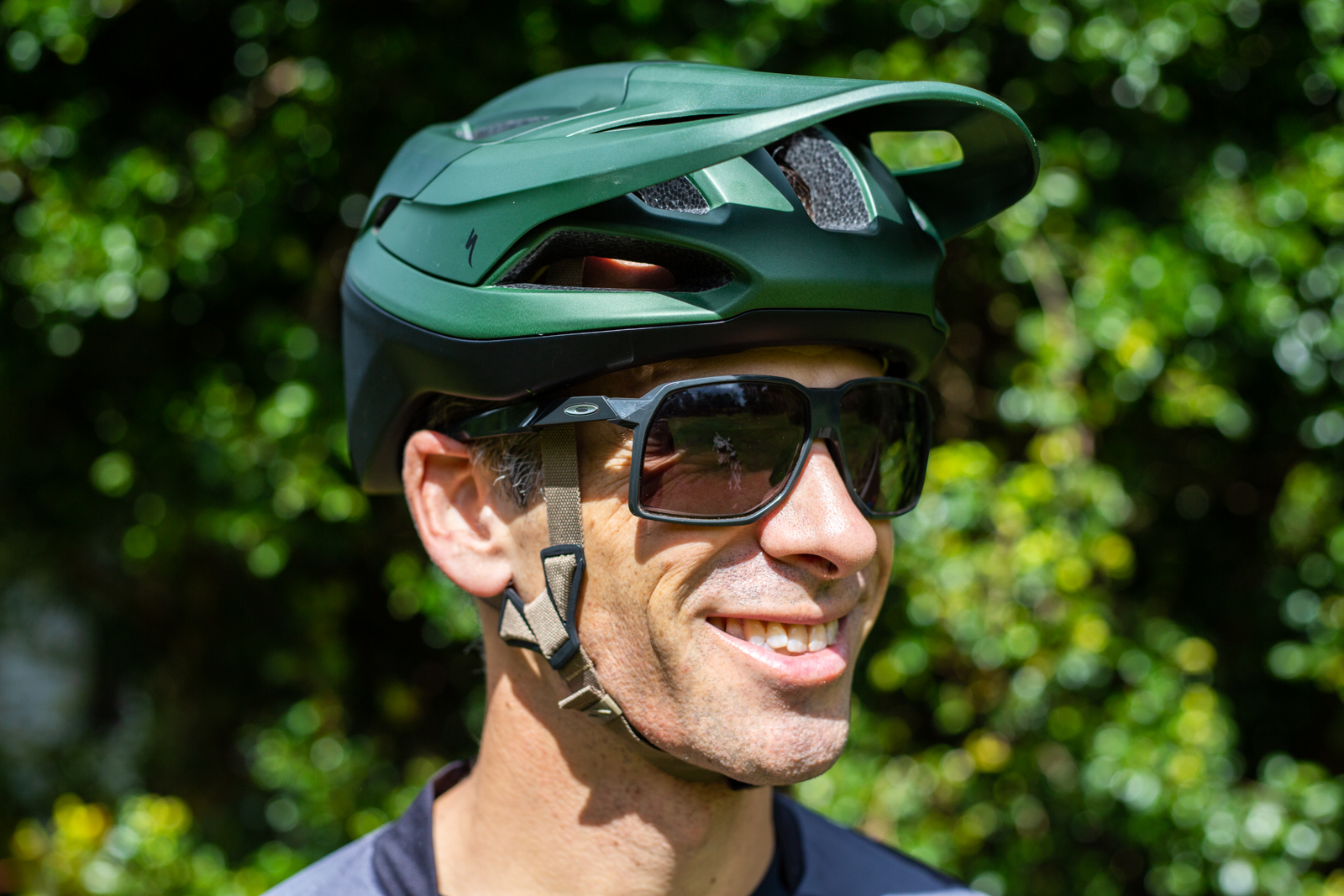
MET Terranova MIPS
RRP: $229.95
From: MET Helmets
Sizes (tested): S, (M), L
Verified weight: 365g
Rotational impact protection: MIPS
Accessory mount: No
Goggle compatible: Yes
Ponytail compatible: Just
Virgina Tech Rating: NA
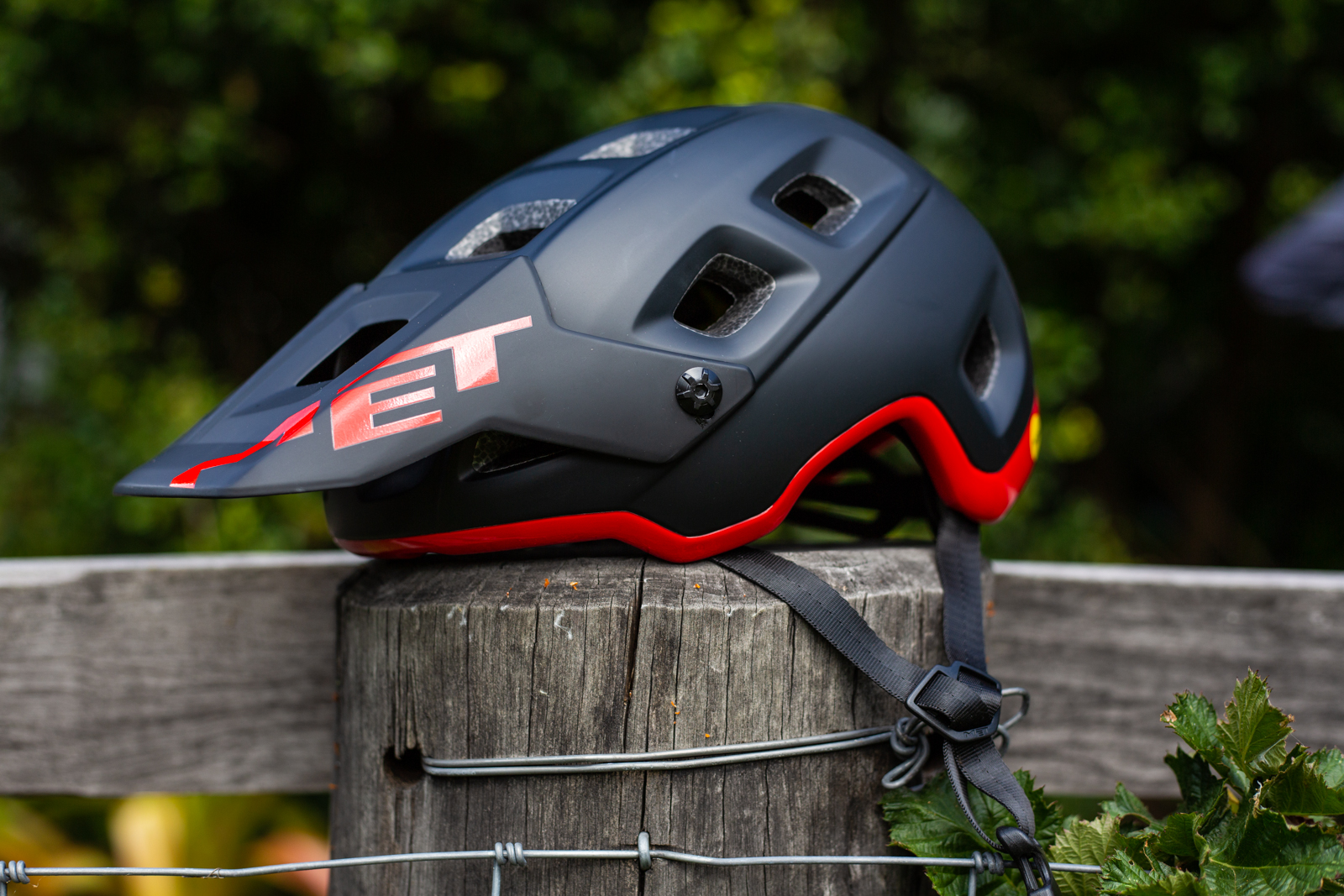
MET’s mid-range trail lid is packed with high-quality features, like a complete shell covering, good internal airflow channeling, MIPS, high quality straps and splitters and a robust visor. The depth of the Terranova isn’t as good as the Specialized Ambush 2 or TLD A3 in the rear, but it’s similar to many of the other helmets and does sit low at the brow and temples. Along with a height adjustable retention system and very adjustable straps, it’s easy to get a secure fit.
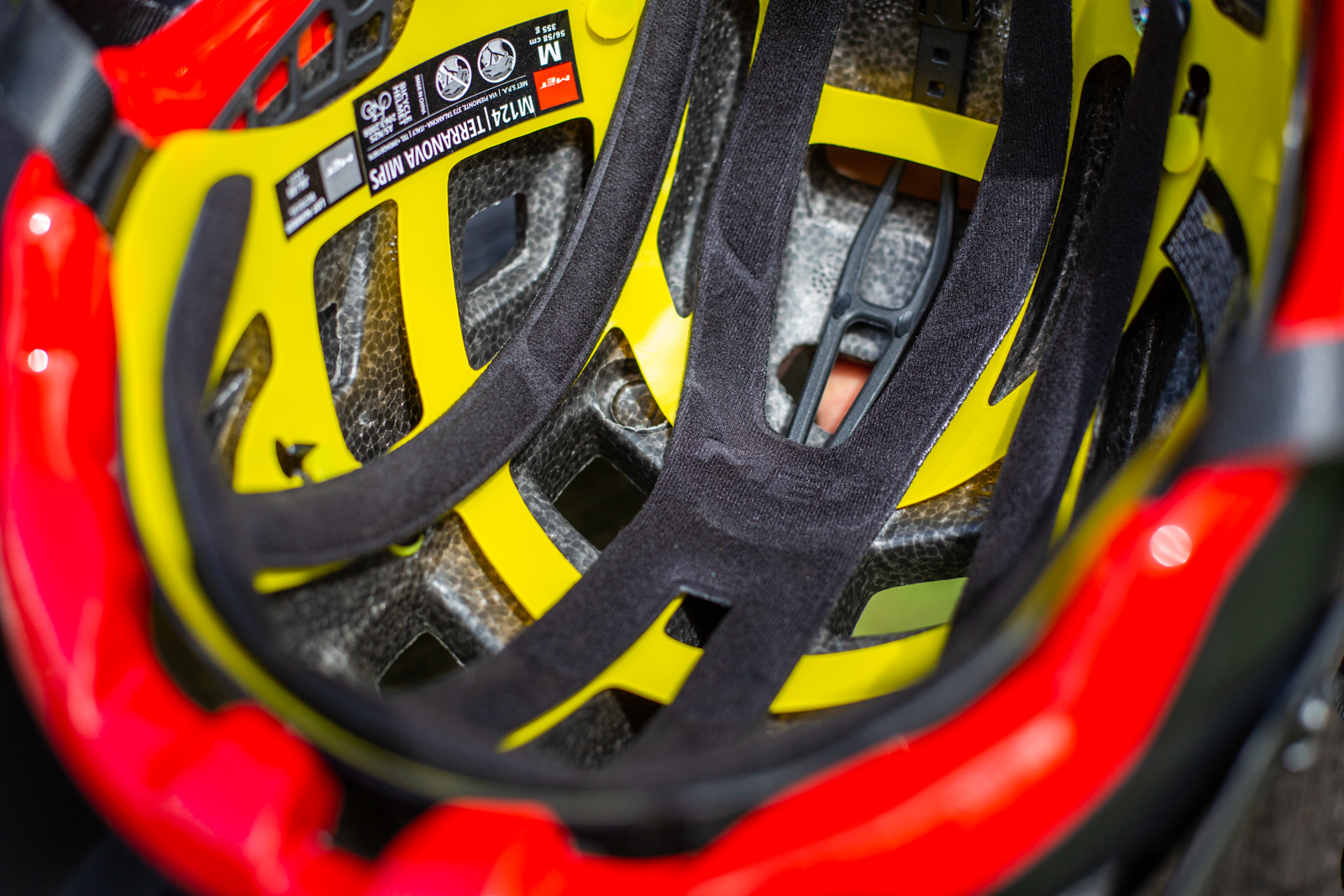
The vents aren’t massive but are aided by the channeling when moving, it is a bit warmer when slogging up a climb. I did have a little bit of interference with my sunglasses, but goggles sat in place and were stowed perfectly. The visor is quite long and can sit up high if needed. I’d like a more secure 3-position option though – it does feel a bit vague. Overall it’s a stable helmet that was very comfortable and looks good, although it could vent better at low speeds.
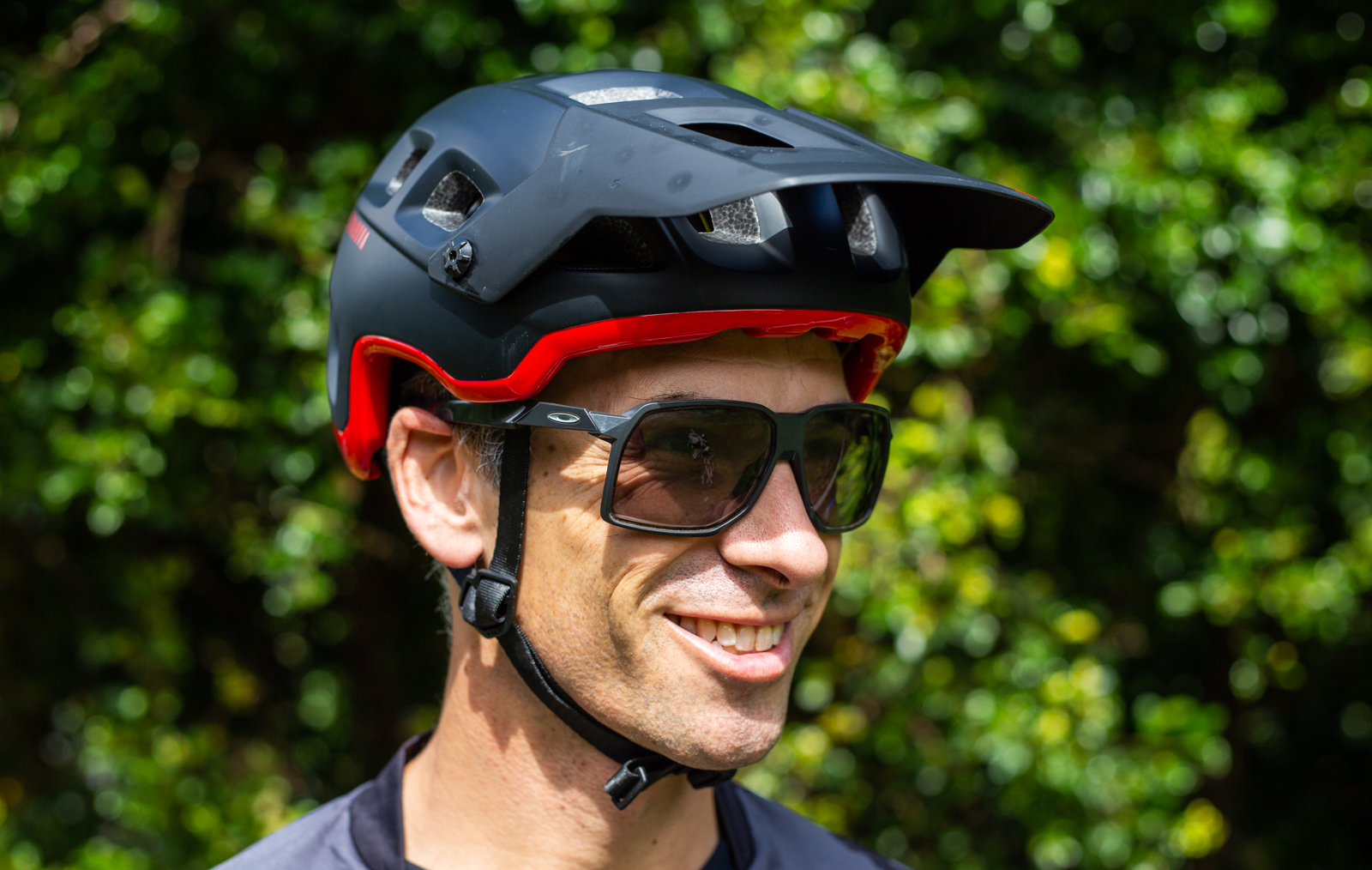
100 Percent Altec
RRP: $269.99
From: FE Sports
Sizes (tested): XS/S, (S/M), L/XL
Verified weight: 385g
Rotational impact protection: Smartshock
Accessory mount: No
Goggle compatible: Yes
Ponytail compatible: Yes
Virgina Tech Rating: NA
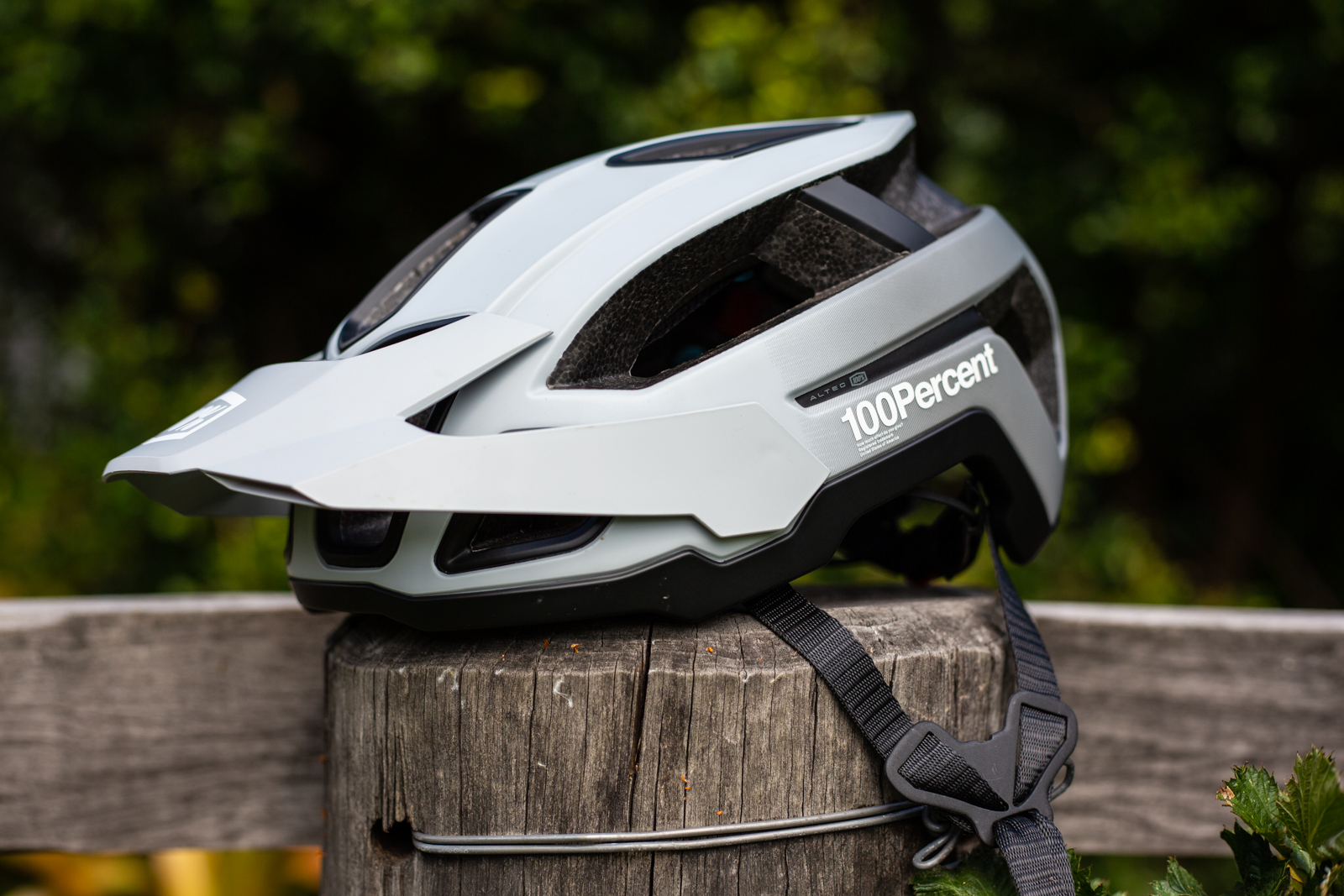
The 100 Percent Altec brings lots of ventilation to a great fit. 100 Percent use multiple foam densities to tune the helmet profile and vent size, and added the Smartshock rotational impact protection. Compared to the Altec there is some vertical retention adjustment, which assists with overall fit and stability. The straps are a basic material that holds sweat more than the tighter woven straps, but the splitters allow for good adjustment, and the magnetic buckle is easy to use. The 3-position visor has a great shape and very positive movement, allowing goggles to sit beneath it if needed.
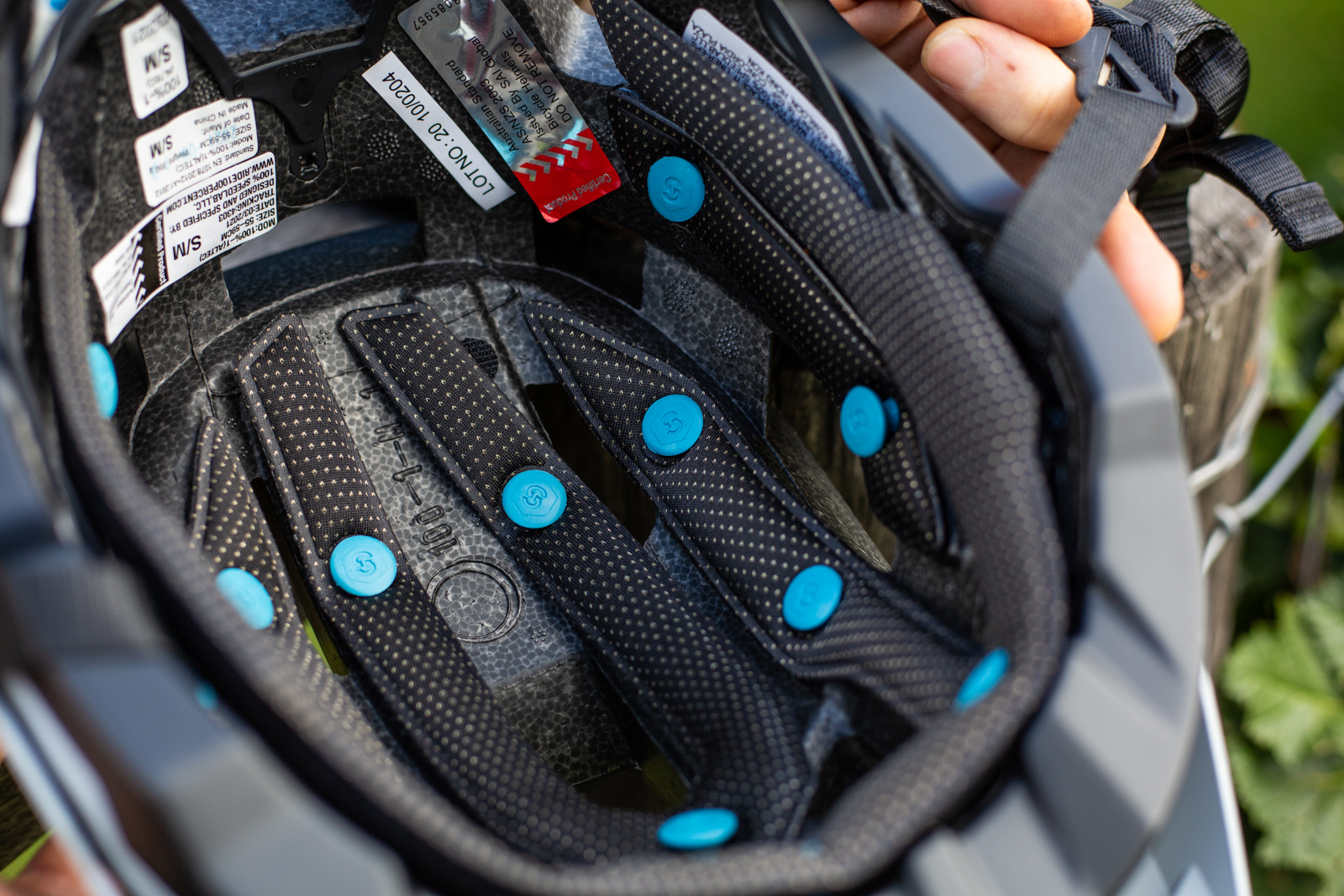
On the trail the airflow is great and the fit is stable, there’s nothing to distract you – except if the Smartshock points touch your head. These are noticeable on the crown of my head on this helmet, but not so on the Altis. It’s a great helmet and many will love the looks and range of colours, but certainly worth trying on for fit and comfort.
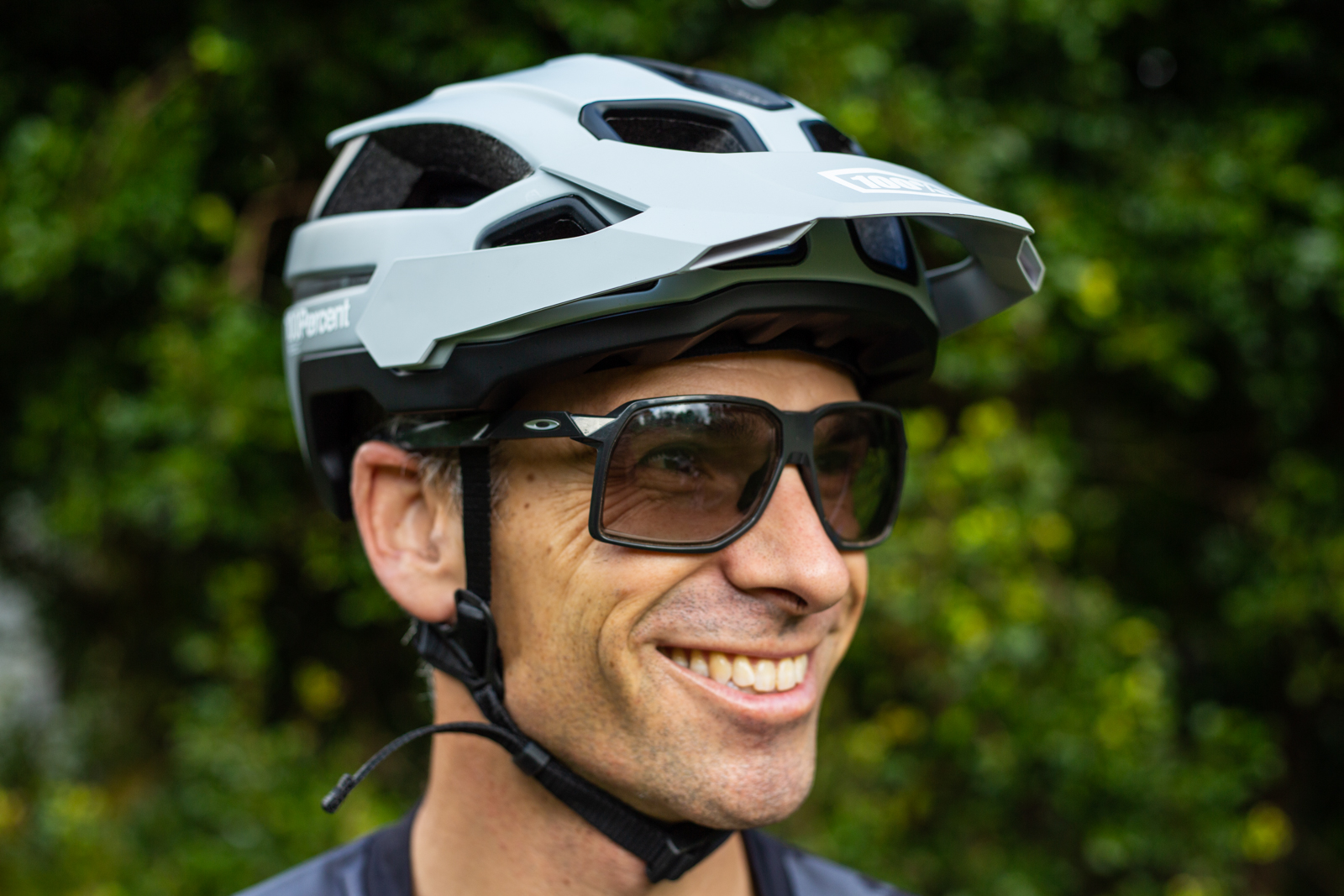
Kask REX
RRP: $359
From: Kask Australia
Sizes (tested): S, (M), L
Verified weight: 393g
Rotational impact protection: No
Accessory mount: Yes
Goggle compatible: Yes
Ponytail compatible: Yes
Virginia Tech Rating: NA
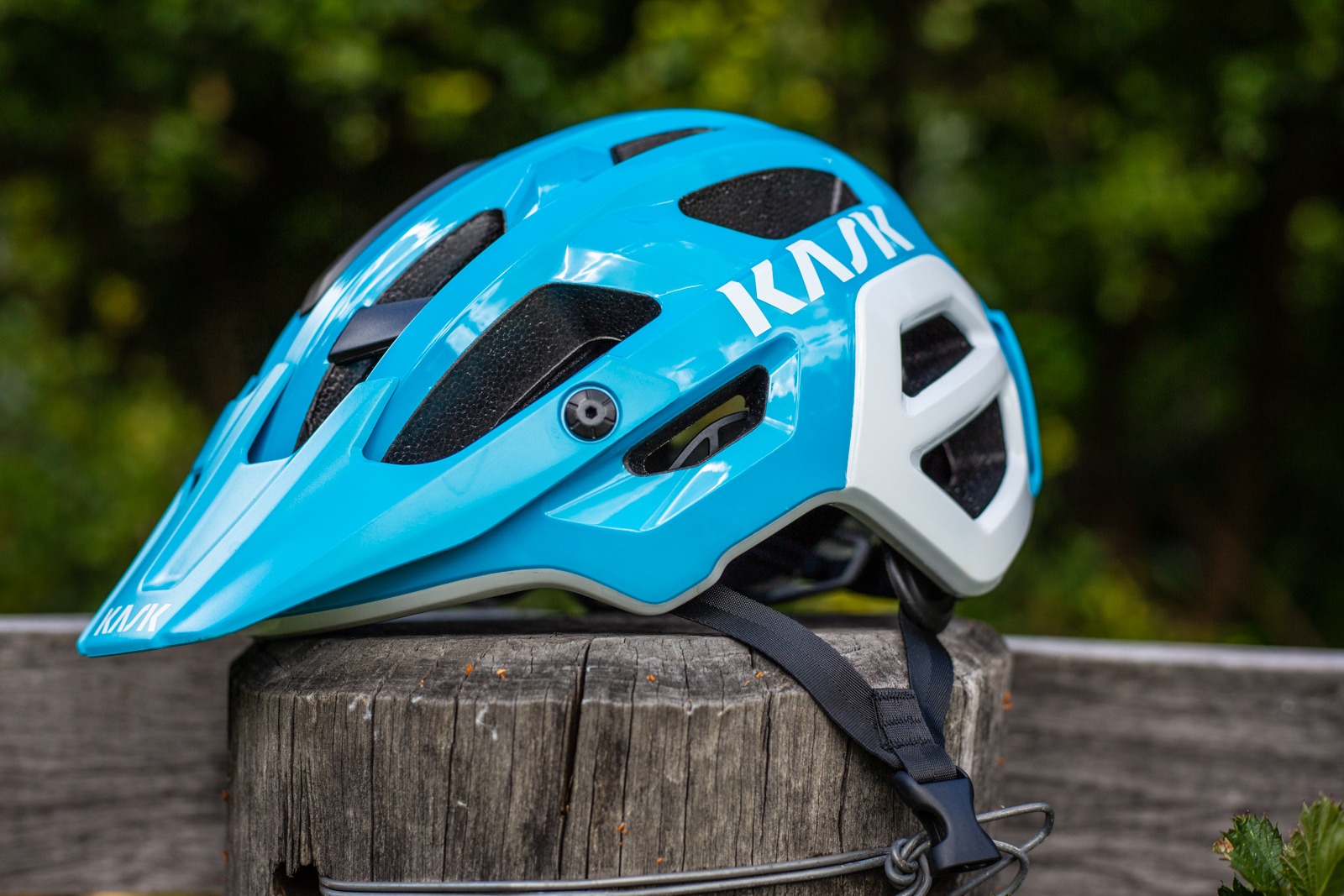
The Italians don’t have a wide range of trail helmets, but the Kask Rex has been a popular model since we first tested one many years ago. The Rex has a full coverage shell with good extended coverage in the rear and at the temples. The EPS foam has reinforced sections that allow quite large vents and cooling channels. The strap cradles are fixed, so you need to see if this fits or not at your dealer – but the material is very good and dries quickly. Kask’s buckle is offset and the eco leather is very comfortable under the chin. With a retention system that has near infinite heighy adjustment, it is easy to get this helmet sitting low and secure, and it feels rock solid. There’s a clip to support your goggle strap, and you can store them below the visor when it’s pushed up. Long arms on sunglasses may foul on the retention system, so check this at your dealer. You can store your eyewear under the visor as well.
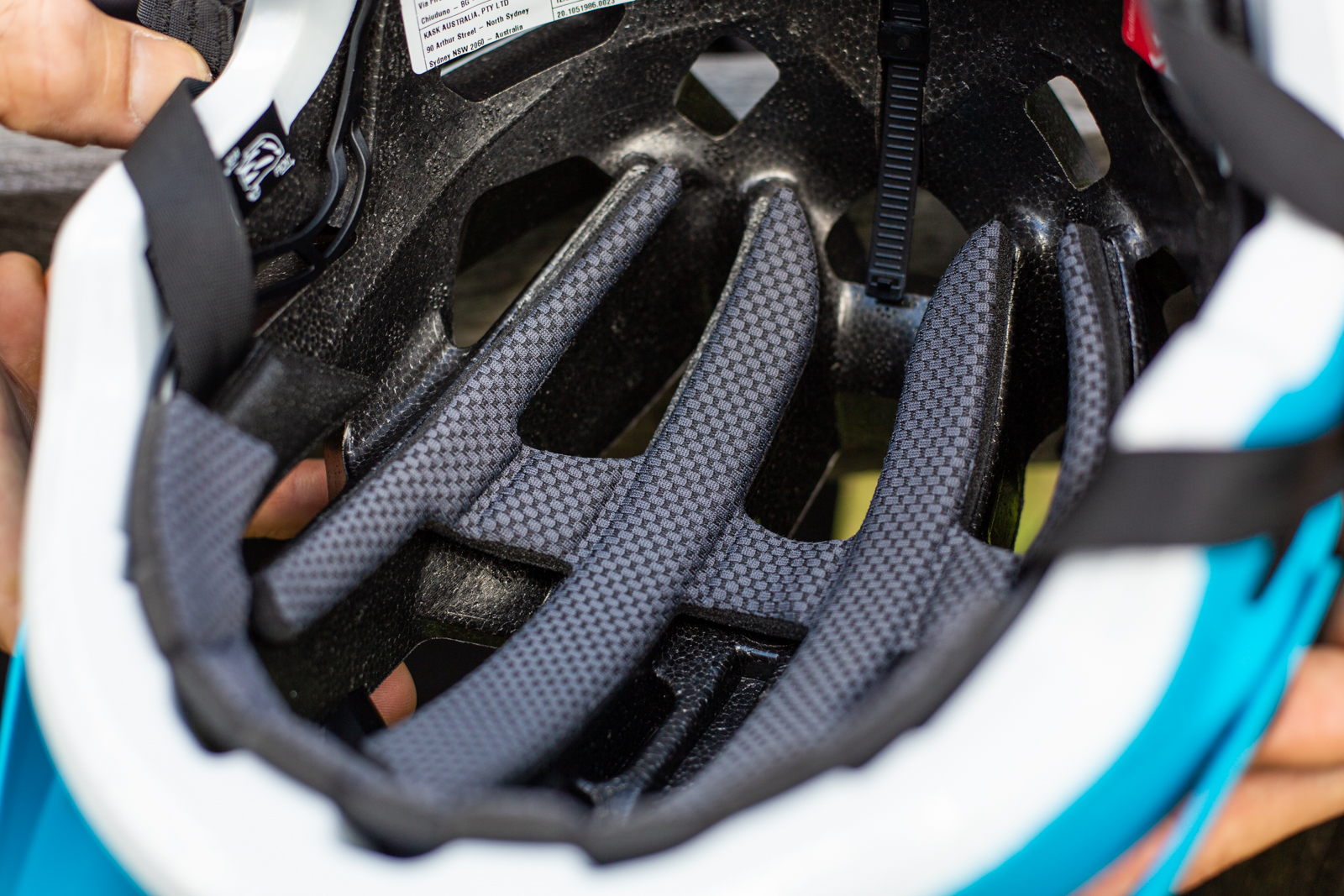
On the trail the airflow is good even at low speed, and most notably the helmet is very stable, in part to having quite a deep, round fit. The pad coverage of the helmet is a big part of the comfort and they stop sweat dripping too. The integrated accessory mount has a cover which is a nice touch to keep it more subtle. This is a very nicely finished helmet that feels sturdy.
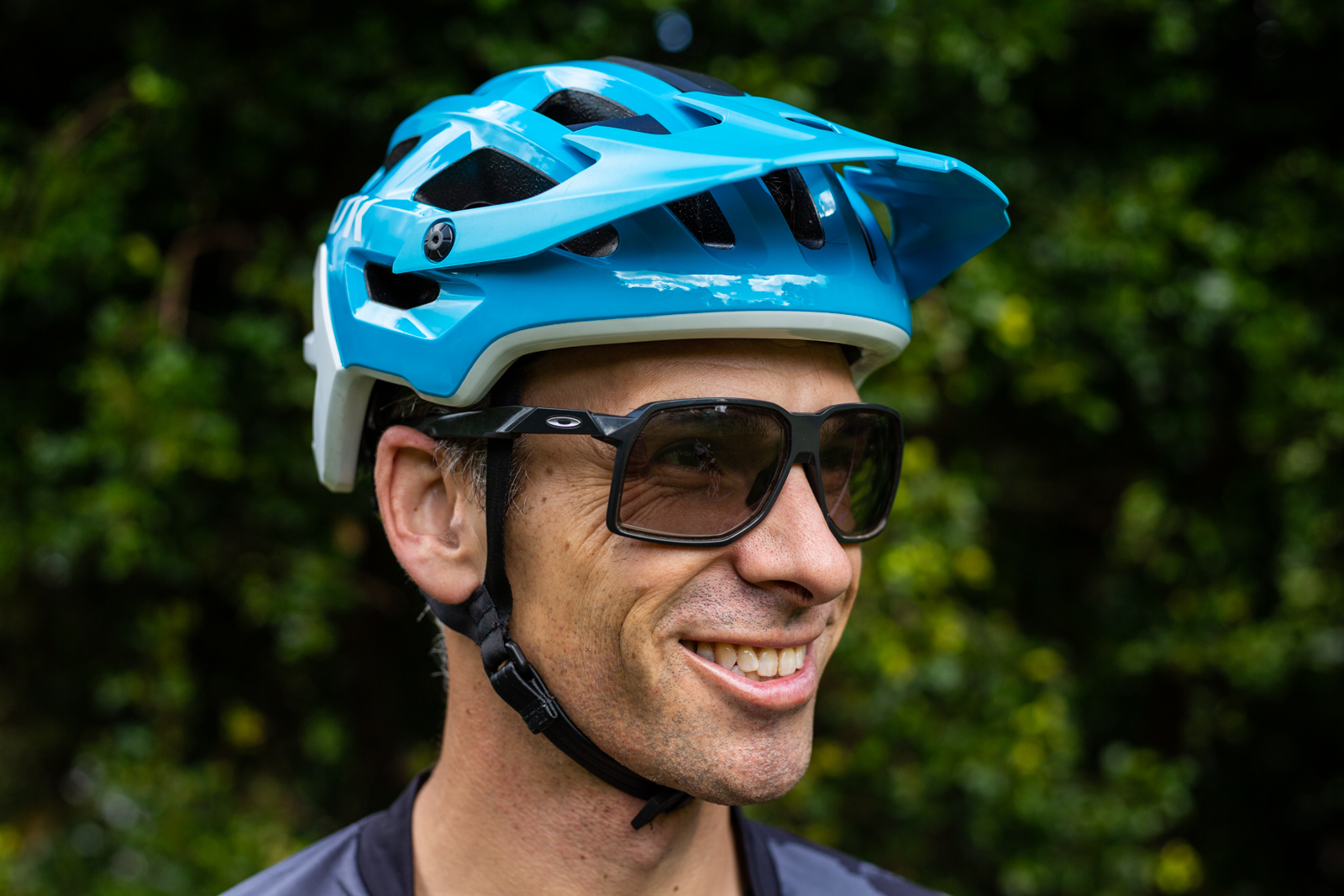
Limar Delta
RRP: $179.95
From: Apollo Bikes
Sizes (tested): (M), L
Verified weight: 344g
Rotational impact protection: No
Accessory mount: No
Goggle compatible: Yes
Ponytail compatible: Not really
Virginia Tech Rating: NA
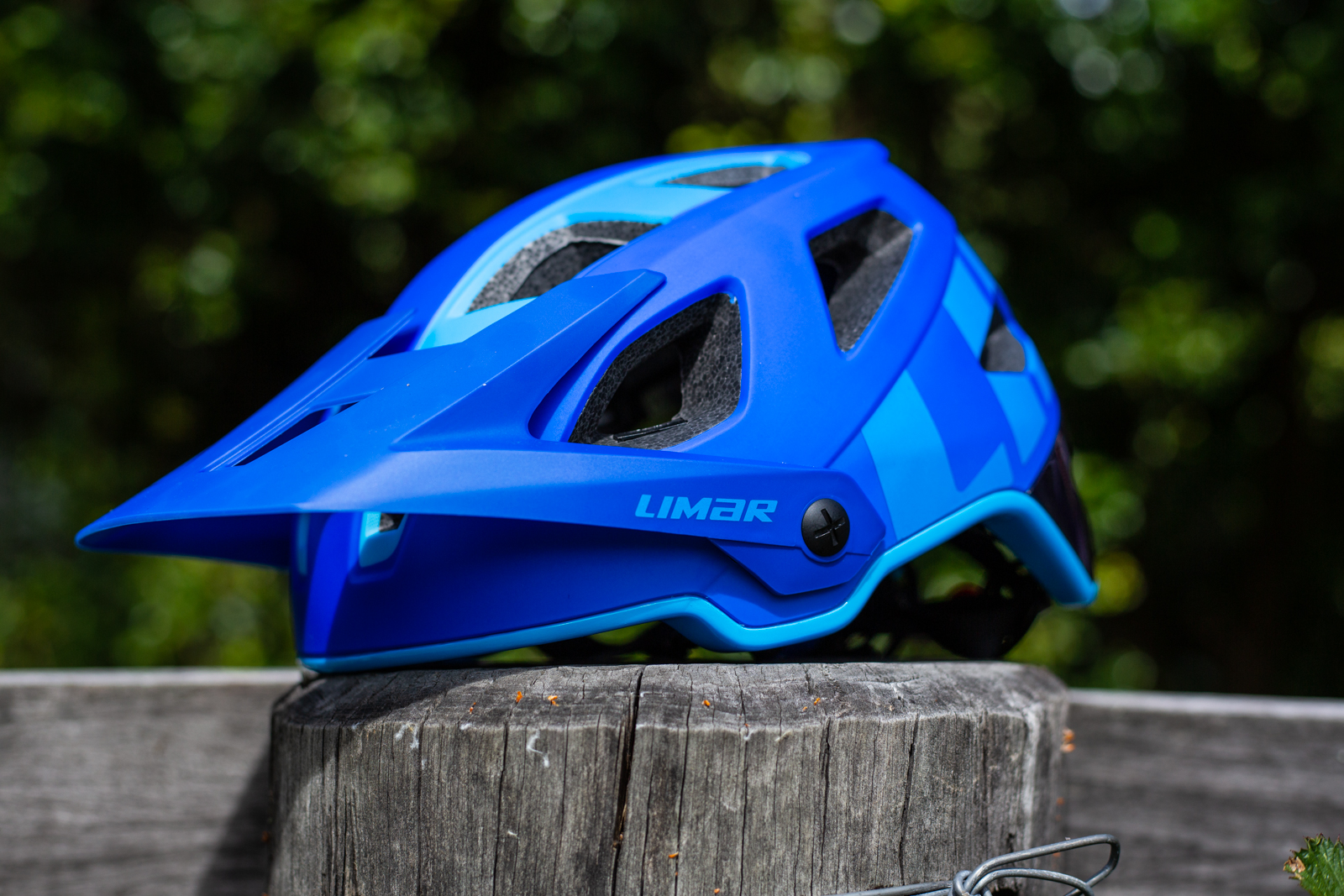
Limar’s Delta helmet is high on value but a little quirky on fit – but that depends on your head shape. The full coverage shell extends further in the back and the temples compared to their road helmets, and the sturdy visor has two positions. While there is a healthy serving of vents, there’s no real cooling channels to promote airflow over your head at speed. The retention system has some height adjustment and it helps for a secure fit. The straps are a softer material that held sweat a bit, with basic strap splitters that provide a lot of adjustment. The buckle is offset and there’s a soft covering for the strap.
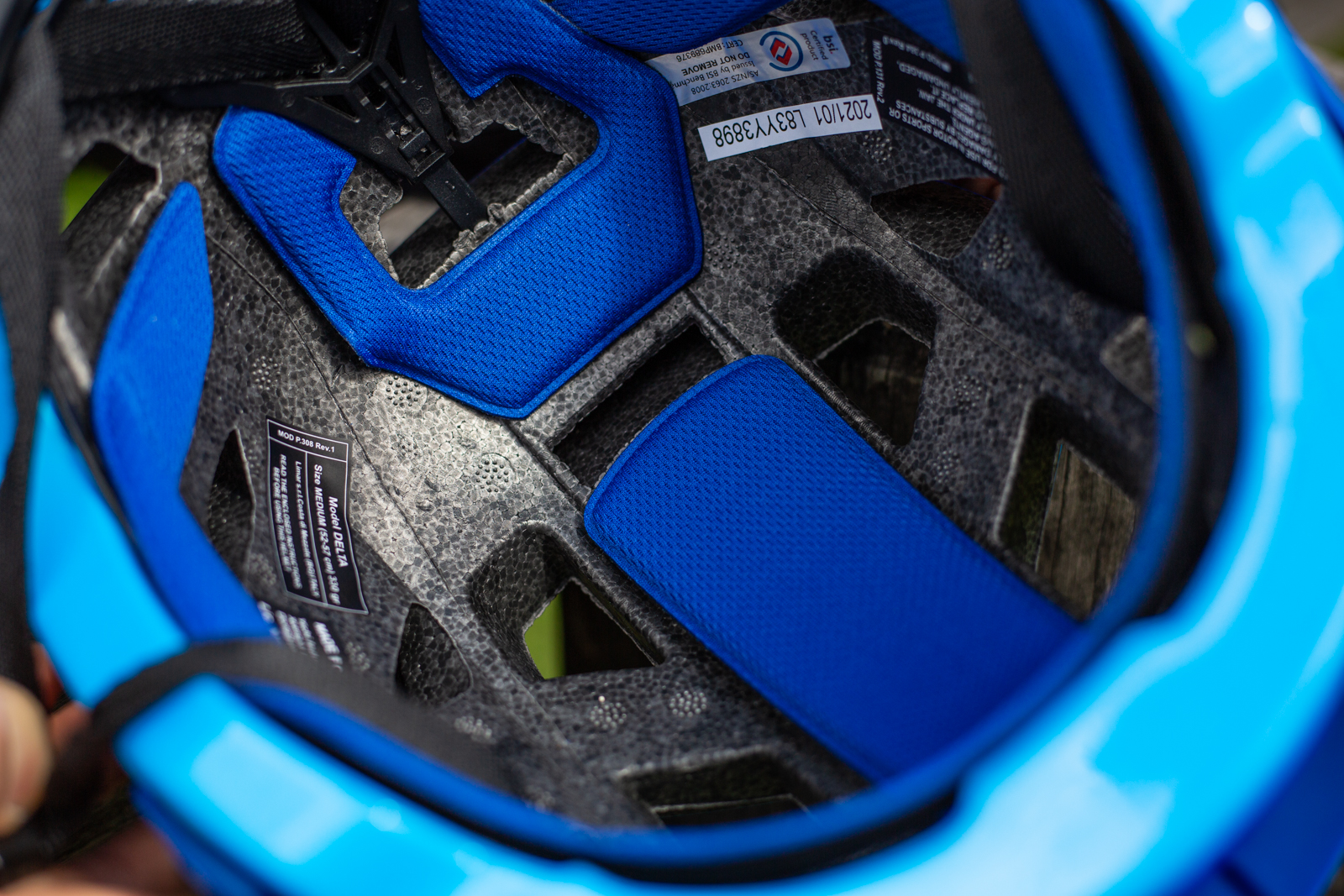
On my head, the shape of the Limar Delta is too round, with pressure on a scar on my forehead and at the back of my head. Still, I found it was a secure fit and it provided good low coverage around the temples, although it could run deeper in the back. Save for the pressure on my forehead the helmet was vented enough and stable enough with a visor out of view that I barely thought about the helmet when riding. And that counts.
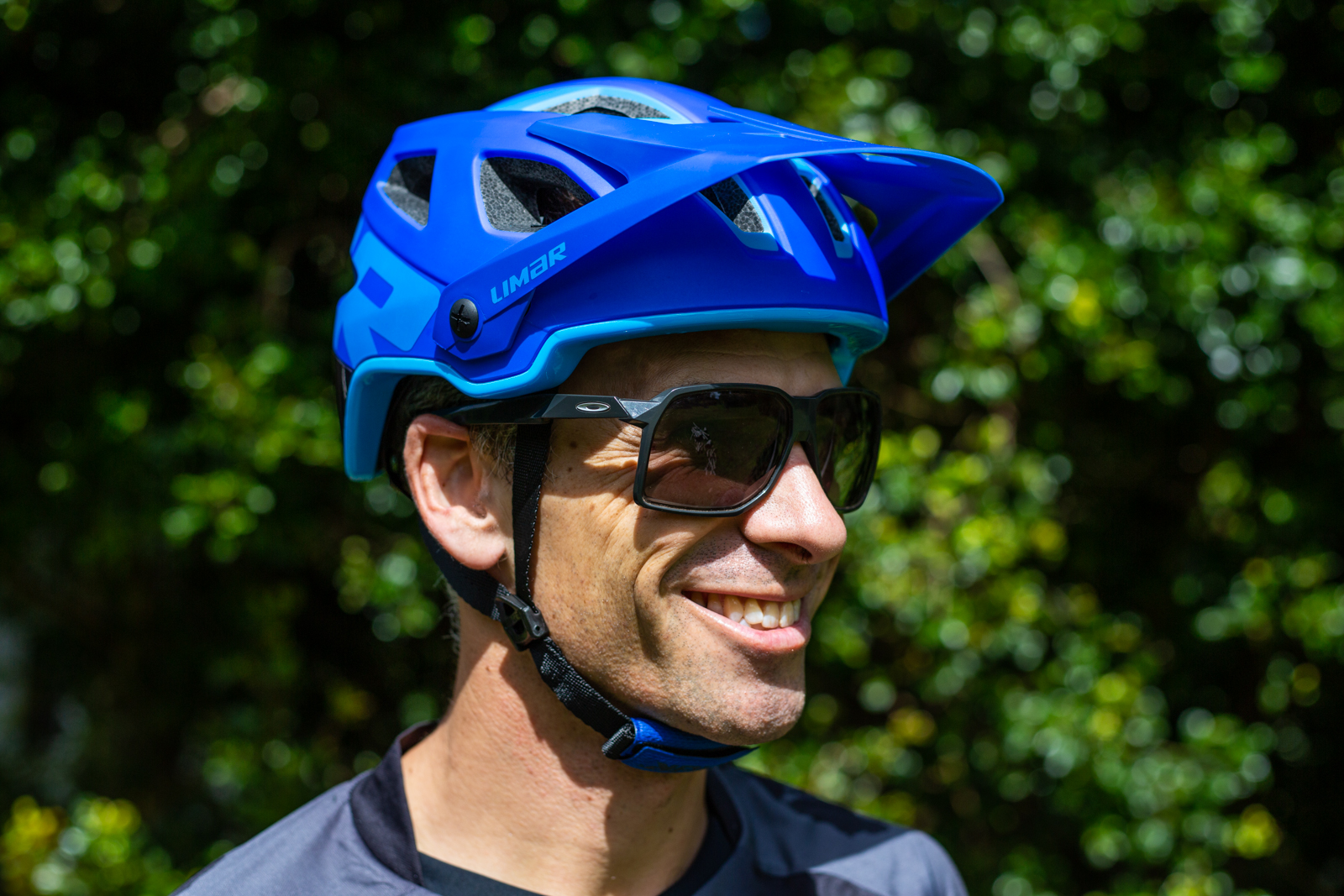
7iDP M2
RRP: $169.95
From: Echelon Sports
Sizes (tested): XS/S, (M/L), XL/XXL
Verified weight: 355g
Rotational impact protection: No
Accessory mount: No
Goggle compatible: No
Ponytail compatible: Not really
Virginia Tech Rating: NA

7iDP pitch the M2 as a light and well-ventilated open face trail helmet. And it ticks those boxes. The M2 has a broad coverage of vents, including very Euro bug mesh for the front vents. The vents run into channels to keep air moving over your head, but it’s open enough that it breathes well even at a snail’s pace on a climb. The shell has slightly extended coverage in the back, although the shell itself doesn’t quite cover all the dual-density EVA foam, leaving a thin edge exposed. It won’t impact the safety, but it will look tatty pretty soon. The retention system has two height options and is easy to wind up, the printed straps have an easy to use strap splitter, although the material does hold sweat a bit. A goggle strap sits securely on the back, but the visor is limited in it’s movement, so they don’t sit below it when not in use.
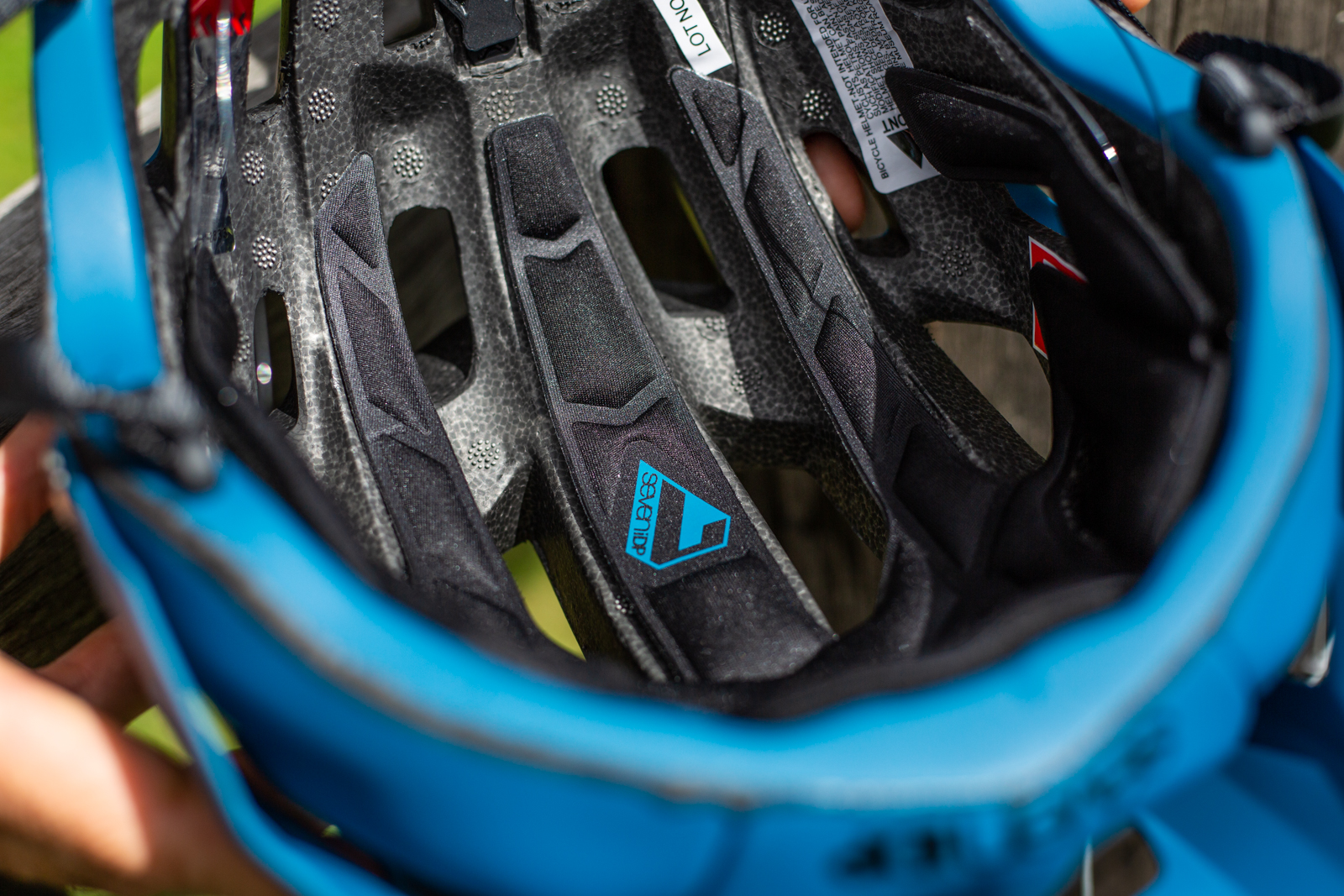
On the trail, this is an airy helmet, feeling more like an XC lid with a visor and some extra coverage. It’s comfortable thanks to good pad coverage, but I’d like more vertical retention adjustment to help keep it more stable. I also wanted to be able to push the visor higher as when in a low position through ditches or off the back looking forward, I had to crane my neck more to see past it. This is a great helmet for someone who doesn’t live for the send but does want good coverage without something too hot or expensive.
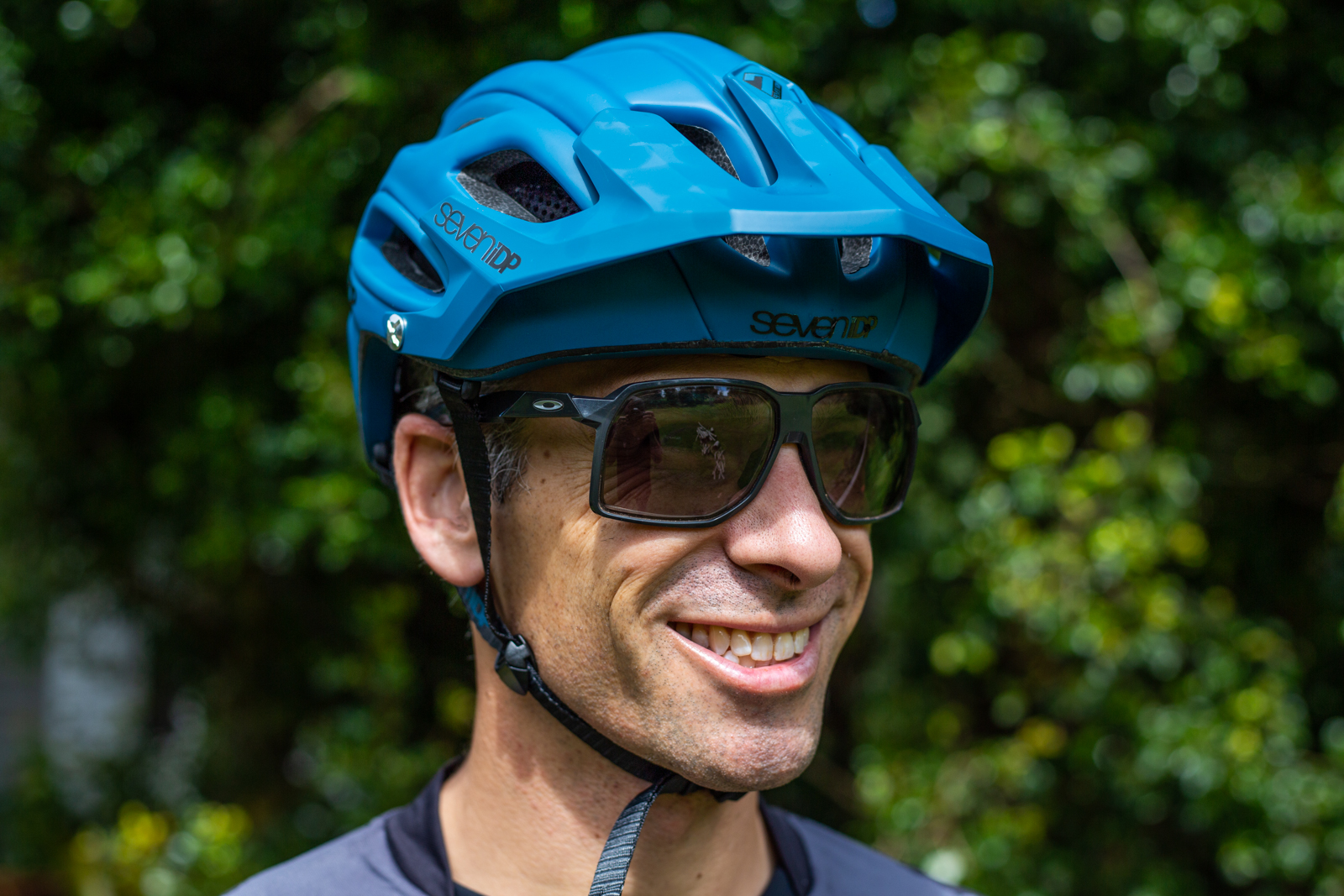
ION Traze AMP MIPS
RRP: $274.99
From: Boards and More
Sizes (tested): S, M, (L)
Verified weight: 381g
Rotational impact protection: MIPS
Accessory mount: No
Goggle compatible: Yes
Ponytail compatible: Yes
Virginia Tech Rating: N/A
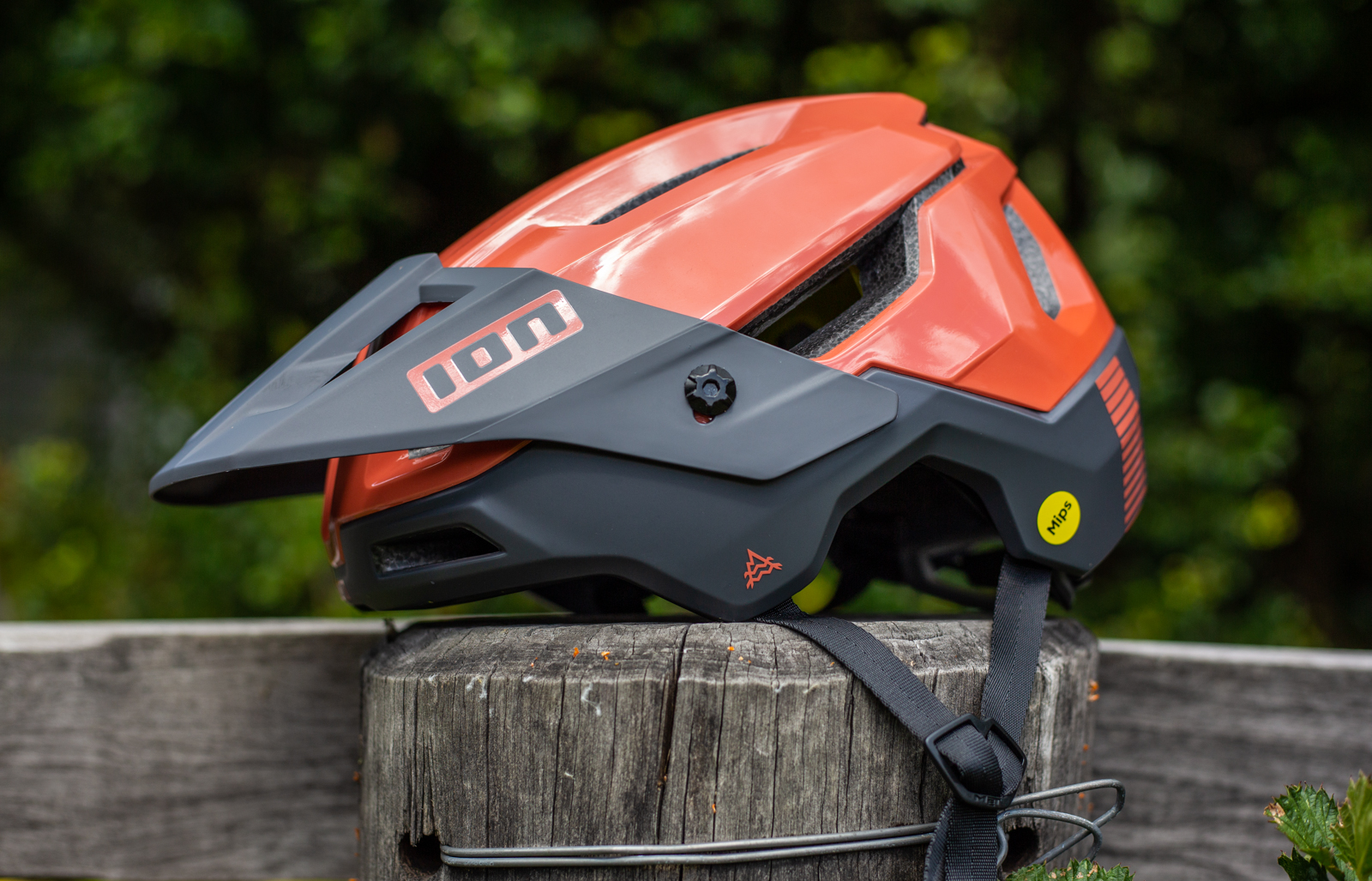
ION have expanded their helmet range, working in partnership with MET for the Traze. It’s an extended coverage trail helmet with a MIPS liner. It has one of the best amounts of coverage of the helmets on test, just behind the TLD A3 and Specialized Ambush 2. It also covers the temples well. A highly adjustable retention system allows a precise fit, even if this was perhaps a size large for me, it felt rock solid. The straps are high quality with a strong finish, they dry fast and use a simple splitter that is easy to adjust. The magnetic buckle is a nice touch. The large front vents under the visor push a lot of air over the channels on the inside, so it runs cooler than it looks. The visor itself feels vague, you can push it up to store your goggles, but it could use some positive position locks.

On the bike the deep fit feels secure and the ventilation is good when moving, but less so when climbing in the heat and humidity. It’s a nice helmet that is comfortable with a secure fit and adequate ventilation, but with some work on the visor it would be much better.

So what helmet is right for you?
All our heads are slightly different shapes, so you really need to try on the helmets that suit your needs to find the one that has the most secure fit. Helmets need to be a snug fit so they do their job, and remember they can only do their job once. The right helmet won’t need to be readjusted every run, and will fit as well as your hair.
Always replace your helmet after a crash, and ask your bike shop about a brand’s crash replacement warranty as well.
Looking for a full-face helmet? Don’t worry, we have a group test in the works!
